Week 1: August 1-7, 2006
PICTURE OF THE MONTH
|
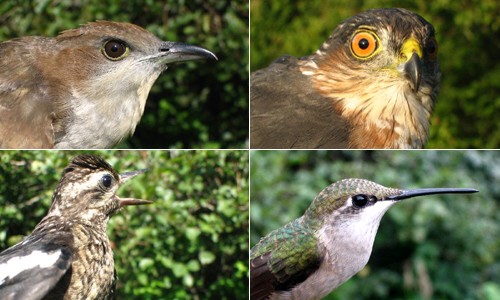 We couldn’t narrow the highlights down to just one, so here are this week’s highlights: a hatch-year Black-billed Cuckoo was the first to be banded at MBO (after one escaped from our nets last Spring); a male third-year Sharp-shinned Hawk was only the 8th for MBO (all banded in fall); a young raucous Yellow-bellied Sapsucker was our 4th; and a young Ruby-throated Hummingbird, though not terribly uncommon, was one of the first to actually be well photographed! (Photos by Seabrooke Leckie) – We couldn’t narrow the highlights down to just one, so here are this week’s highlights: a hatch-year Black-billed Cuckoo was the first to be banded at MBO (after one escaped from our nets last Spring); a male third-year Sharp-shinned Hawk was only the 8th for MBO (all banded in fall); a young raucous Yellow-bellied Sapsucker was our 4th; and a young Ruby-throated Hummingbird, though not terribly uncommon, was one of the first to actually be well photographed! (Photos by Seabrooke Leckie) –
|
| |
THIS WEEK |
ALL |
2006 TOTAL |
SITE TOTAL |
| # birds (and species) banded |
152 (30) |
152 (30) |
1087 (72) |
6140 (96) |
| # birds (and species) repeat |
22 (10) |
22 (10) |
259 (28) |
1137 (43) |
| # birds (and species) return |
6 (5) |
6 (5) |
104 (21) |
173 (26) |
| # species observed |
75 |
75 |
153 |
178 |
| # net hours |
419.9 |
419.9 |
3531.7 |
9953.8 |
| # birds banded / 100 net hours |
36.2 |
36.2 |
30.8 |
61.6 |
Note: table does not include nocturnal banding (owls).
Bander-in-charge: Seabrooke Leckie Assistants: Jennifer Bridgeman, Sophie Cauchon, Diane Demers, Jean Demers, Barbara Frei, Emily Gray, Gay Gruner, Marie-Anne Hudson, Isabel Julian, Barbara MacDuff, Andre Pelletier, Andrew Plimer, Clemence Soulard
Notes: The first week of fall 2006 got off to a rolling start on August 1. Although some effort was made in 2005 to obtain coverage in August, this is the first year at MBO in which there has been full coverage each week this month. A total of 150 birds were banded over the course of the week, averaging a fairly steady mid-twenties each day.
The 1st and 2nd were especially hot and humid, so the total of 48 banded over the two days was somewhat surprising. Movement was restricted, for the most part, to the local breeders on the first day, although a post-breeding male Nashville Warbler was captured, who had dispersed to the site to complete his fall moult prior to departing for his wintering grounds. More migrants and post-breeding dispersal were seen on the 2nd, with an Ovenbird, an American Redstart and two White-throated Sparrows, both still in juvenal plumage.
The morning of the 3rd dawned overcast and threatening rain, which reduced net hours to less than half of the normal total for the day. Only six birds were banded, and the site felt generally quiet all morning. A visiting ornithologist from Australia spent the morning volunteering with us, with the hope of seeing some new species – he had the misfortune of coming out on the quietest day all week, but we were still able to share some of our wonderful avifauna with him.
Things picked up again the next day with the return of clear weather. Our first small movement of warblers was evident, both in the nets and on census. A total of 23 birds were banded, of which eleven were warblers. Three Tennessee Warblers were captured, all females, two of which were adults undergoing their prebasic moult. A Nashville Warbler and an Ovenbird, as well as an American Redstart on census, were among the others to move into the area.
A cold front and north winds overnight produced another small influx of birds on the 5th. Expectations were high for the day when we captured 14 birds on the first round alone, however activity tapered off following that and we only caught another 15 all rest of the morning. Despite this, another two Tennesees, a redstart and an Ovenbird were banded, as well as two Veerys, still in their speckled juvenal plumage, most likely dispersed from nests in the forests of the Arboretum next door. On census, both Myrtle and Black-and-white Warblers made their first showing of the season. Song Sparrow numbers peaked with a DET of 40 in the area; many were concentrating around the fallen apple tree at the parking area, as well as in the mown grass surrounding the newly set-up J-trap. This suggests the trap may be quite successful once it’s completely up and running. Our highest species count for the week was recorded on the 5th, with a total of 51 seen or banded.
A similar pattern of capture was observed on the 6th, with a busy early couple of rounds tapering off later in the morning. One of the first captures of the day was of a third-year male Sharp-shinned Hawk, enticed perhaps by the warbler in the net (we report that his attempt was thwarted). An Eastern Kingbird and a Yellow-bellied Sapsucker were banded, both uncommon birds in the net, but the indisputable highlight of the day, and possibly the week, was a hatch-year Black-billed Cuckoo captured on one of the last rounds. This is an uncommon visitor to MBO, and represents the first banding record of the species at the station.
Despite breezy conditions and patchy skies, the week wrapped up with our highest banding total of the period, with 29 new birds. Almost half of this total is due to a single flock of predominantly young Baltimore Orioles that flew into one net later in the morning. Another Ovenbird and the season’s first Magnolia Warbler were also captured on earlier rounds. However, despite the banding total, little was observed moving around the area, as the birds remained mostly quiet all morning – it was just us, the crickets and the cicadas!
This week’s top 10 [last month’s rank in brackets]
| # individuals banded |
mean # individuals observed daily |
| 1. Song Sparrow (33) [1] |
Red-winged Blackbird (120) [1] |
| Yellow Warbler (22) [4] |
Song Sparrow (35) [2] |
| Baltimore Oriole (14) [10] |
American Goldfinch (19) [3] |
| Gray Catbird (8) [-] |
Cedar Waxwing (18) [7] |
| Rose-breasted Grosbeak (8) [3] |
European Starling (17) [-] |
| Black-capped Chickadee (6) [-] |
Black-capped Chickadee (15) [-] |
| Downy Woodpecker (5) [-] |
American Robin (13) [4] |
| Traill’s Flycatcher (5) [-] |
Common Grackle (13) [6] |
| Cedar Waxwing (5) [-] |
American Crow (12) [-] |
| Tennessee Warbler (5) [-] |
Yellow Warbler (10) [9] |
This week’s top 10 is substantially different from July’s, with many species banded in fairly large numbers as breeders begin migrating and young disperse or band together in large flocks. These flocks become evident when you look at the number of individuals observed daily – the Red-winged Blackbirds have rocketed from 18 to 120 individuals seen per day!
|
 Peter Gruner and his friend Fred did a wonderful job restoring/rebuilding the existing J-trap. We expect to have it fully operational by the end of the week. (Photo by Barbara Frei) Peter Gruner and his friend Fred did a wonderful job restoring/rebuilding the existing J-trap. We expect to have it fully operational by the end of the week. (Photo by Barbara Frei)
|
Week 2: August 8-14, 2006
PICTURE OF THE WEEK
|
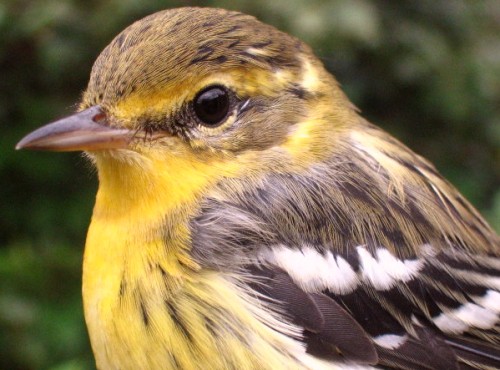 This hatch-year male Blackburnian Warbler is only the second to be banded at MBO. (Photo by Seabrooke Leckie)- This hatch-year male Blackburnian Warbler is only the second to be banded at MBO. (Photo by Seabrooke Leckie)-
|
| |
THIS WEEK |
ALL |
2006 TOTAL |
SITE TOTAL |
| # birds (and species) banded |
225 (40) |
377 (46) |
1312 (79) |
6365 (96) |
| # birds (and species) repeat |
31 (11) |
53 (15) |
290 (32) |
1168 (51) |
| # birds (and species) return |
6 (3) |
13 (6) |
110 (21) |
179 (26) |
| # species observed |
84 |
91 |
155 |
180 |
| # net hours |
426.5 |
846.4 |
3958.2 |
10380.3 |
| # birds banded / 100 net hours |
52.8 |
44.5 |
33.1 |
61.3 |
Note: table does not include nocturnal banding (owls).
Bander-in-charge: Seabrooke Leckie Assistants: Jean Beaudreault, Diane Demers, Jean Demers, Barbara Frei, Emily Gray, Gay Gruner, Marie-Anne Hudson, Barbara MacDuff, Sandra Minotti, Chris Murphy, Greg Rand, Katleen Robert, Clemence Soulard
Notes: Week two got off to an excellent start with the shift of the winds from south on the 7th to northwest on the 8th as a cold front moved in, bringing with it birds from the north. A total of 43 new birds were banded on Tuesday, with birds remaining active later into the morning in the cooler weather. The catch consisted predominantly of Song Sparrows, Baltimore Orioles, and Rose-breasted Grosbeaks which were encountered throughout the morning in small flocks.
Wednesday dawned even cooler, but the winds had shifted back to the southwest, stalling any further large movement. However, despite the lower banding totals, ones and twos of some new species were observed, including season firsts of Scarlet Tanager, Cape May Warbler and Northern Waterthrush. One of two exciting species that turned up this week was observed late in the morning near the parking area: a Sedge Wren, discovered by Barbara Frei, represents the first record for MBO! The photographic proof is below.
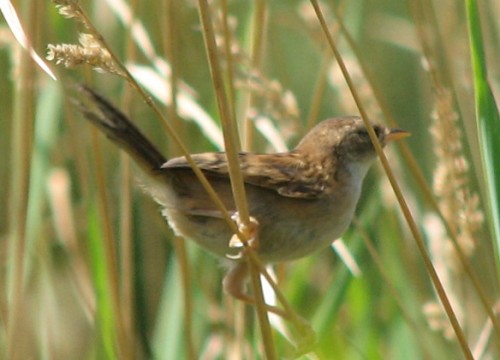 (Photo by Barbara Frei)
(Photo by Barbara Frei)
Overcast periods kept bird activity a bit lower on the 10th, but several new species were captured in the nets. Undoubtedly the banding highlight of the week was a HY Blackburnian Warbler, only the second of this species banded by MBO to date. As if that weren’t enough, a Warbling Vireo captured late in the morning is just the fourth for the station. New arrivals continued to trickle in with the addition of Wilson’s and Canada Warblers.
Despite north winds overnight, activity was generally low on Friday. The early-morning air was full of the ‘tsee’ call notes of Song Sparrows, a distinctive sound of autumn, whose numbers peaked on this day. A large flock of 14 birds, nearly all Song Sparrows, were caught in one net on the first round, but the rest of the day was mostly quiet. The first Ruby-crowned Kinglet, an early AHY undergoing her fall moult, was captured late in the morning. A total of nine warbler species was tallied at the end of the day including new arrivals Black-throated Green and Bay-breasted Warblers.
Things continued slow for the 12th, with just 18 new birds banded, the second lowest total since the beginning of the season. Because of the combination of few birds and reasonable staffing, the L net group was opened for the first time this season. Hopes were to catch some of the warblers that were moving through the area, but it didn’t fare much better than the rest of the nets. The first Chestnut-sided Warbler was banded, along with singles of Tennessee and Canada. A Solitary Sandpiper spotted on the back ponds was new for the season.
Cool temperatures and the shifting of winds from west to northwest overnight brought in another small push of birds for the 13th. Song Sparrows continued to be among the most abundant birds at the site, with 15 banded. Small numbers of Baltimore Orioles and a few warblers were also present. The second exciting bird of the week was a Caspian Tern heard calling as it flew over the site to the west early in the morning, also the first record of the species for the station!
The final day of the period, the 14th, was the busiest of the season so far. A total of 64 birds were captured, the majority of which were during the first two net rounds. Highlights included the season’s first Philadelphia Vireo and Black-throated Blue Warbler, both banded. A species total of 51 for the morning tied our previous season high, but warblers showed the most diversity of the season so far with a total of 13 species detected at the site.
This week’s top 10 [last month’s rank in brackets]
| # individuals banded |
mean # individuals observed daily |
| 1. Song Sparrow (78) [1] |
Song Sparrow (47) [2] |
| Baltimore Oriole (25) [3] |
Red-winged Blackbird (35) [2] |
| Rose-breasted Grosbeak (17) [5] |
American Goldfinch (22) [3] |
| Yellow Warbler (13) [2] |
American Crow (22) [9] |
| Cedar Waxwing (6) [9] |
American Robin (18) [7] |
| American Redstart (6) [-] |
Cedar Waxwing (17) [4] |
| Ovenbird (6) [-] |
Baltimore Oriole (16) [-] |
| Canada Warbler (6) [-] |
Black-capped Chickadee (16) [6] |
| Traill’s Flycatcher (4) [8] |
Blue Jay (11) [-] |
| Chestnut-sided Warbler and Indigo Bunting (4) [-] |
Common Grackle (10) [8] |
While Song Sparrow remains at the top of the list of species banded on the week, the increase in numbers of Baltimore Orioles and Rose-breasted Grosbeaks, as well as the addition of several new species to the list, predominantly warblers, indicates that migration is gearing up into full swing!
|
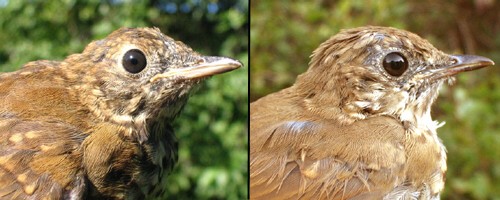 What a difference a week makes! This juvenile Veery (left), banded on the 5th, was recaptured this week showing its hatch-year plumage coming in (right), the result of its first prebasic moult. (Photos by Seabrooke Leckie) What a difference a week makes! This juvenile Veery (left), banded on the 5th, was recaptured this week showing its hatch-year plumage coming in (right), the result of its first prebasic moult. (Photos by Seabrooke Leckie)
border=”0″ src=”/wp-content/mbophotos/06fa02_BAOR.jpg” width=”500″ height=”375″> We’ve noticed some strange looking Baltimore Orioles flying around MBO, and we’ve been lucky enough to band and photograph several of them. This strange colouration is likely due to a shift in their diet. We’re investigating whether the brightly-coloured mountain-ash or honeysuckle berries might be the culprits. (Photo by Seabrooke Leckie)
|
Week 3: August 15-21, 2006
PICTURE OF THE WEEK
|
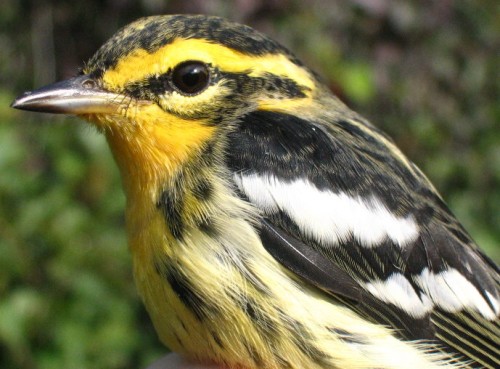 No, we didn’t forget to update the photo! For a second straight week, a Blackburnian Warbler was the highlight. This time three individuals were caught on one day, including this after-hatch-year male (compare with last week‘s hatch-year male, and note especially the difference in the primary coverts). (Photo by Seabrooke Leckie)- No, we didn’t forget to update the photo! For a second straight week, a Blackburnian Warbler was the highlight. This time three individuals were caught on one day, including this after-hatch-year male (compare with last week‘s hatch-year male, and note especially the difference in the primary coverts). (Photo by Seabrooke Leckie)-
|
| |
THIS WEEK |
ALL |
2006 TOTAL |
SITE TOTAL |
| # birds (and species) banded |
162 (31) |
539 (48) |
1474 (79) |
6527 (96) |
| # birds (and species) repeat |
33 (12) |
86 (19) |
323 (32) |
1201 (51) |
| # birds (and species) return |
1 (1) |
14 (7) |
111 (21) |
180 (26) |
| # species observed |
78 |
95 |
155 |
180 |
| # net hours |
390.9 |
1237.3 |
4349.1 |
10771.2 |
| # birds banded / 100 net hours |
41.4 |
43.6 |
33.9 |
60.6 |
Note: table does not include nocturnal banding (owls).
Bander-in-charge: Seabrooke Leckie Assistants: Jean Beaudreault, Diane Demers, Jean Demers, Barbara Frei, Emily Gray, Gay Gruner, Marie-Anne Hudson, Barbara and Don MacDuff, Sandra Minotti, Chris Murphy, Greg Rand, Katleen Robert, Clemence Soulard, John Webster
Notes: The first day of week three set the general tone for the rest of the week. Warmer morning temperatures and west winds overnight didn’t bring in many new birds, and only 13 individuals were banded. However, a small flock of warblers spotted on census included a new bird for the season, Northern Parula. A Broad-winged Hawk was the first of a few to be spotted over a few days at the beginning of the week, cruising lazily high above the site.
Wednesday was a bit of a surprise for the staff who were present. With identical conditions to Tuesday, we were expecting a slow morning, but were in fact kept quite busy with a total of 54 birds captured. Just goes to show, you never know what tomorrow will bring! A strong movement of warblers was recorded, both banded and observed, and a large group of Baltimore Orioles was also banded, the two species groups accounting for 37 of the birds captured. We were pleased to discover a second (or possibly the same) Sedge Wren on opening round along the main path; he perched and sang for a short period, but disappeared after that and wasn’t seen again all morning.
Things became quiet again on the 17th and persisted through to the 20th. An average of just under 14 birds per day were banded over this period. A Great Crested Flycatcher was banded on the 18th, but there were generally few banding highlights. A group of five Green Herons flew over the site together on the 17th, and we were lucky enough to watch a Cooper’s Hawk chase a Pileated Woodpecker from the dead tree on the 19th. A Whip-poor-will was spotted on the 20th sitting on the main Arboretum road on the way in to the site in the morning. A few warblers and flycatchers continued to move through over the four days, but in small numbers.
Activity picked up for the last day of the week, with 40 birds captured. North winds and patches of rain overnight probably contributed to the increased numbers. Our highest species count of the week was recorded this day, with a total of 53 observed or banded, including 15 species of warblers (our greatest single-day diversity so far this season). MBO’s third, fourth and fifth Blackburnian Warblers were captured, and a Yellow Palm Warbler, new for the season, was spotted on census. A Red-shouldered Hawk was discovered in a net near the end of the morning, but just managed to escape before staff could reach him. Too bad, it would’ve been a good end to a good day!
As we round the corner into the end of August, we can expect warbler diversity to remain high and anticipate busier days throughout the next few weeks. It should be an exciting period, with lots of surprises in store!
This week’s top 10 [last week’s rank in brackets]
| # individuals banded |
mean # individuals observed daily |
| 1. Song Sparrow (46) [1] |
Song Sparrow (40) [1] |
| Baltimore Oriole (18) [2] |
American Crow (27) [4] |
| Magnolia Warbler (12) [-] |
American Goldfinch (18) [3] |
| Ovenbird (8) [5] |
Bobolink (15) [-] |
| American Redstart (7) [5] |
Cedar Waxwing (15) [6] |
| Nashville Warbler (7) [-] |
American Robin (13) [5] |
| Common Yellowthroat (5) [-] |
Black-capped Chickadee (11) [8] |
| Canada Warbler (4) [5] |
Baltimore Oriole (11) [7] |
| Traill’s Flycatcher (4) [9] |
Common Grackle (10) [10] |
| Yellow Warbler [4], House Wren [-], Gray Catbird [-] (4) |
Blue Jay (10) [9] |
The lists show some interesting changes beginning to occur. While Song Sparrow and Baltimore Oriole remained the most frequently banded birds for a second week in a row, Rose-breasted Grosbeaks have already dropped off considerably, and the first wave of (we presume, given last year’s results) many Magnolia and Nashville Warblers arrived. The biggest changes among species observed were the virtual disappearance of Red-winged Blackbirds, and sudden increase in Bobolinks, which landed them among the most numerous birds of the week, a first for MBO. This addition will certainly delight one of our banders-in-charge, Barbara Frei, who studies these little guys. We’re sure she’ll be sitting by the fence bordering the east side, scanning the corn field for BOBOs.
|
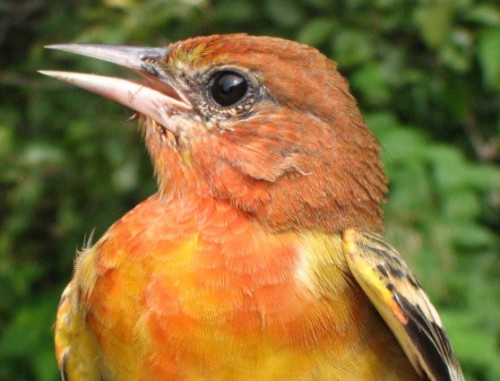 Just as this week’s Blackburnian Warbler was more colourful than the one featured in last week’s report, so is the Baltimore Oriole above. The colouration is particularly remarkable given that it is a hatch-year bird, which would normally be expected to be rather pale yellow-orange. We are curious to learn whether others are also spotting such reddish orioles, and are interested in further exploring what may be causing this abnormal pigmentation. (Photo by Seabrooke Leckie) Just as this week’s Blackburnian Warbler was more colourful than the one featured in last week’s report, so is the Baltimore Oriole above. The colouration is particularly remarkable given that it is a hatch-year bird, which would normally be expected to be rather pale yellow-orange. We are curious to learn whether others are also spotting such reddish orioles, and are interested in further exploring what may be causing this abnormal pigmentation. (Photo by Seabrooke Leckie)
|
Week 4: August 22-28, 2006
PICTURE OF THE WEEK
|
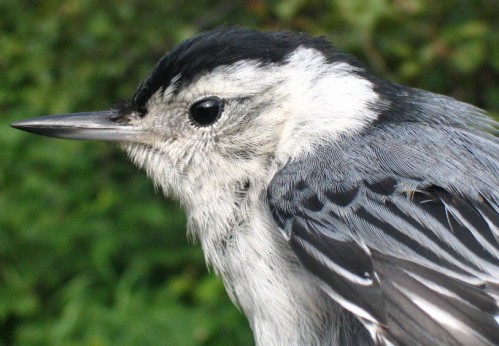 Despite having several breeding (or at least territorial) pairs on site, this White-breasted Nuthatch is only the 3rd to be banded at MBO. (Photo by Seabrooke Leckie)- Despite having several breeding (or at least territorial) pairs on site, this White-breasted Nuthatch is only the 3rd to be banded at MBO. (Photo by Seabrooke Leckie)-
Note: table does not include nocturnal banding (owls).
| |
THIS WEEK |
ALL |
2006 TOTAL |
SITE TOTAL |
| # birds (and species) banded |
200 (34) |
739 (54) |
1674 (80) |
6727 (96) |
| # birds (and species) repeat |
25 (10) |
111 (23) |
348 (35) |
1226 (52) |
| # birds (and species) return |
2 (2) |
16 (8) |
113 (22) |
182 (26) |
| # species observed |
82 |
101 |
155 |
180 |
| # net hours |
412.8 |
1650.1 |
4761.9 |
11184.0 |
| # birds banded / 100 net hours |
48.4 |
44.8 |
35.2 |
60.1 |
Bander-in-charge: Seabrooke Leckie Assistants: Jean Beaudreault, Sophie Cauchon, Averill Craig, Jean Demers, Barbara Frei, Emily Gray, Gay Gruner, Marie-Anne Hudson, Betsy McFarlane, Sandra Minotti, Chris Murphy, Daniel Ouellette, Andre Pelletier, Clemence Soulard, John Webster
Notes: At dawn of the opening morning of week 4, staff were greeted with the sounds that would become the background chorus for the week: the call notes of flocks of warblers as they began to wake up. Although banding numbers were about average on the 22nd, small mixed flocks of warblers and flycatchers were observed all morning. A high count of 5 Northern Waterthrush were banded on Tuesday, and a total of 7 were detected on both Tuesday and Wednesday. Waterthrush numbers seem to be up at many stations, which suggests a very successful breeding year for them.
Calm conditions early on Wednesday encouraged another small push of warblers to move in, though just a small number were banded. The 23rd saw the highest total of Bobolinks of the season to date. These birds haven’t been recorded often at MBO in previous seasons, but this fall several flocks have been using the cornfield next to the MBO site for daytime foraging (and likely roosting).
The 24th was the second busiest day of the week, with a total of 47 birds captured during the morning. The most numerous of the birds captured were Magnolia Warblers, with 13 banded, but small numbers of Northern Waterthrush and Nashville Warbler were also present. The first Myrtle Warbler banded this fall made its appearance on Thursday, as well as the first Brown Thrasher. However, the highlight of the morning was a White-breasted Nuthatch, only the third to be banded by MBO – despite being a relatively common bird at the site, they just don’t seem to get caught that often!
Overcast and cool conditions on Friday encouraged some early migrant movement at the site, but as the clouds cleared and the sun came out activity dropped off, so about half of the day’s captures were from the first hour. A Warbling Vireo was caught late in the morning, and the first male Black-throated Blue Warbler was part of the early flocks. The week’s 2 most interesting captures, from an oddities point of view, were both caught on Friday. The first was a hatch-year male American Redstart showing unusually bright orange patches for his age (usually hatch-year males will show yellowish-orange patches), as well as reddish tinting to the feathers of his back and wings. The second was a hatch-year Song Sparrow completing an unusual – and previously undocumented – moult pattern. Photos of both are featured below.
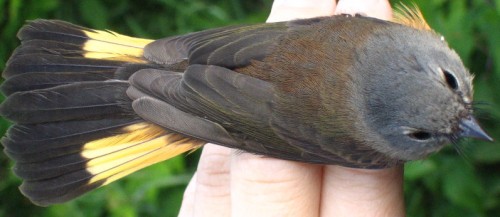 (Photo by Seabrooke Leckie) (Photo by Seabrooke Leckie)
|
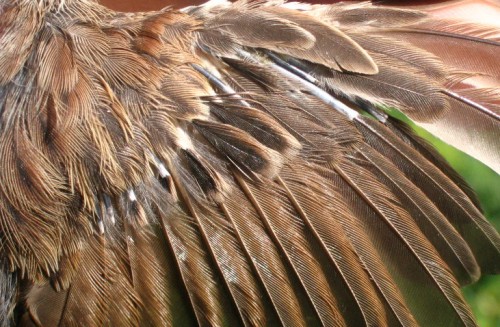 Here’s an example of how recapturing a bird can lead to interesting insights. This Song Sparrow was banded earlier in August and was distinctly in juvenile plumage at the time. Upon recapture on August 25, it was seen to be replacing its primary coverts sequentially, along with the corresponding primaries. Such a pattern of feather replacement was believed to occur only during second and subsequent prebasic moults, but as this bird has shown, there is still a lot to be learned about even the most common species. (Photo by Seabrooke Leckie) Here’s an example of how recapturing a bird can lead to interesting insights. This Song Sparrow was banded earlier in August and was distinctly in juvenile plumage at the time. Upon recapture on August 25, it was seen to be replacing its primary coverts sequentially, along with the corresponding primaries. Such a pattern of feather replacement was believed to occur only during second and subsequent prebasic moults, but as this bird has shown, there is still a lot to be learned about even the most common species. (Photo by Seabrooke Leckie)
|
Things slowed down significantly for the 26th, despite cool temperatures and north winds. A meager 14 birds were captured on this morning, although this included our 100th species detected this fall at MBO: a hatch-year Blackpoll Warbler. Late in the morning, as the sun rose higher and the air started to warm up, we were treated to a small movement of diurnal raptors that included Turkey Vulture, Northern Harrier, Red-shouldered Hawk, Red-tailed Hawk and Broad-winged Hawk.
Activities on the 27th were extremely limited as we had our first morning rainfall of the season. Only 4 net-hours were squeezed in before the rain began to fall, and just 2 birds were captured. A rather soggy BIC completed census, and total species detected for the morning was a season low, due to weather conditions and reduced observation time.
However, as if to make up for lost time, Monday was our busiest day of the season so far. Staff were kept busy with 81 birds captured. Flocks of warblers were moving through the area in small numbers, and the majority of the birds caught were from foraging groups entering a net together (imagine 15 warblers all in one net!). Among the interesting warblers banded were the first Bay-breasted Warbler of the season, a female Blackburnian, 2 Blackpoll, a Canada, a Mourning, 5 Wilson’s and an amazing 21 Magnolia Warblers!
This week’s top 10 [last week’s rank in brackets]
| # individuals banded |
mean # individuals observed daily |
| 1. Magnolia Warbler (39) [3] |
Common Grackle (49) [7] |
| Song Sparrow (26) [1] |
American Crow (41) [2] |
| Northern Waterthrush (19) [-] |
Song Sparrow (33) [1] |
| American Redstart (12) [5] |
American Goldfinch (22) [4] |
| Ovenbird (10) [7] |
Cedar Waxwing (19) [5] |
| Tennessee Warbler (10) [-] |
Bobolink (18) [3] |
| Wilson’s Warbler (9) [-] |
Red-winged Blackbird (17) [-] |
| Nashville Warbler (8) [6] |
Blue Jay (13) [-] |
| American Goldfinch (7) [-] |
Black-capped Chickadee (12) [9] |
| Common Yellowthroat (7) [7] |
Magnolia Warbler (10) [-] |
This week’s top ten highlights the warbler push that has gone through MBO this past week, with all but 2 spots on the banding list occupied by warblers! The apparent leap to the top that the Common Grackles made this week is slightly deceptive, as it’s mostly due to a few large flocks moving through on one day, and similarly nearly half of the crows observed this week were recorded on a single morning.
With north winds and cool overnight temperatures forecasted for most of the upcoming week, we can likely expect more of the same in the days that follow!
|
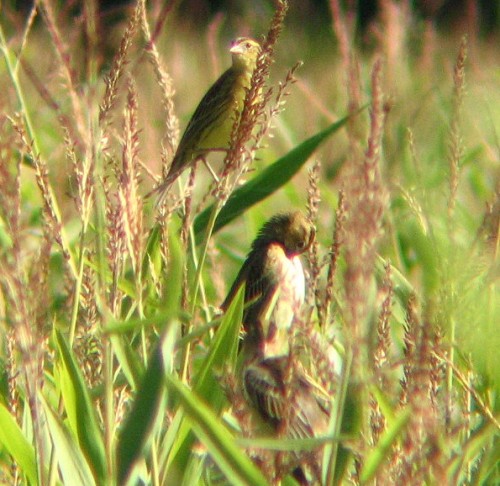 We were lucky enough to have a camera on hand when MBO’s mysterious Bobolinks posed for this shot. Their appearance this fall certainly reinforces the notion that birds do not necessarily use the same feeding or roosting sites year after year, and highlights the importance of continued monitoring over coming fall seasons. (Photo by Seabrooke Leckie) We were lucky enough to have a camera on hand when MBO’s mysterious Bobolinks posed for this shot. Their appearance this fall certainly reinforces the notion that birds do not necessarily use the same feeding or roosting sites year after year, and highlights the importance of continued monitoring over coming fall seasons. (Photo by Seabrooke Leckie)
|
Week 5: August 29 – September 4, 2006
PICTURE OF THE WEEK
|
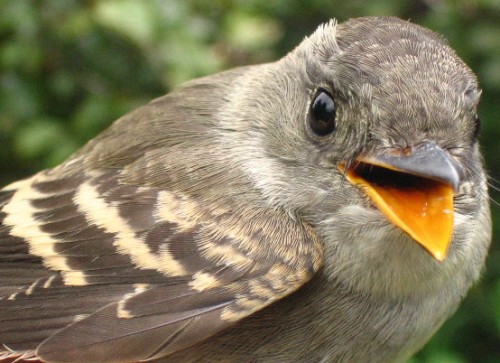 It seems like the flycatchers always have something to say to the camera; this Eastern Wood-Pewee was no exception. It was the first one caught this fall, and only the fifth ever banded at MBO. (Photo by Seabrooke Leckie)- It seems like the flycatchers always have something to say to the camera; this Eastern Wood-Pewee was no exception. It was the first one caught this fall, and only the fifth ever banded at MBO. (Photo by Seabrooke Leckie)-
|
Note: table does not include nocturnal banding (owls).
| |
THIS WEEK |
ALL |
2006 TOTAL |
SITE TOTAL |
| # birds (and species) banded |
146 (37) |
885 (58) |
1820 (80) |
6873 (96) |
| # birds (and species) repeat |
19 (8) |
130 (24) |
367 (35) |
1245 (52) |
| # birds (and species) return |
1 (1) |
17 (9) |
114 (22) |
183 (26) |
| # species observed |
88 |
106 |
155 |
180 |
| # net hours |
343.7 |
1993.8 |
5105.6 |
11526.0 |
| # birds banded / 100 net hours |
42.5 |
44.4 |
35.6 |
59.6 |
Bander-in-charge: Seabrooke Leckie Assistants: Martin Bowman, Sophie Cauchon, Diane Demers, Jean Demers, Emily Gray, Gay Gruner, Marie-Anne Hudson, Barbara MacDuff, Betsy McFarlane, Chris Murphy, Andre Pelletier, Katleen Robert, Clemence Soulard
Notes: Week 5 has been our slowest week thus far this season, with just 147 birds banded during the seven day period despite consistent north winds. Certainly the totals from the last day of the previous update period remain unmatched, and most days this week fewer than 30 birds were banded. Good conditions overnight encouraged the birds from last Monday to move on, and while a few warbler flocks were encountered on Tuesday, the count area was relatively quiet. However, an Olive-sided Flycatcher spotted on census provided a nice highlight. Our most interesting captures for the 29th came in the form of non-bird life: a bat was caught in the half-light of opening round, and a Gray Treefrog was discovered in one of the nets later in the morning.
Numbers continued to decrease on Wednesday, with steady but low activity in the nets all morning. Several small groups of warblers were observed moving through the area, though they successfully evaded capture. Among the flocks were three Northern Parulas, a Philadelphia Vireo and a high count of 16 Common Yellowthroats. The first Lincoln’s Sparrow of the season was captured among the flocks of warblers.
Despite ideal weather conditions overnight, Thursday and Friday were both very quiet days, with just 22 birds banded between them. However, both days afforded some excellent birding, and in fact Thursday produced our highest one-day species total for the fall so far, with 57 species tallied. Highlights among these included Scarlet Tanager, Cape May Warbler, a lateish Purple Martin, and a low-flying Broad-winged Hawk. A noticable influx of White-throated Sparrows was present on the 31st, and Song Sparrow and American Goldfinch numbers were also quite high. On the first day of September we were treated to the spectacle of about 300 Common Grackles swirling and circling above the lab, and landing in the trees and bushes just to the west. Fortunately most of them managed to avoid the nets, but we did band two females from the flock.
Activity picked up a bit for the 2nd as several flocks of warblers were observed in the count area. A small group of them were captured early which included Blackburnian, Bay-breasted, Blackpoll and Mourning Warblers. Hawks were prominent in the area with several accipiters as well as a Northern Harrier and the local Red-shouldered Hawk spotted, most while they were being harried by vigilent crows. The Common Grackles seem to have formed a roost somewhere to the north, as another 550 flew over in a narrow stream early in the morning.
Sunday was wet and rainy, resulting in no net hours and very little observation time. Census was completed by an intrepid and well-prepared volunteer. Little of note was observed, and the species total of 18 was even lower than last week’s rainy day.
However, once again activity rebounded the following day, and while not quite as busy as last Monday, a total of 45 birds were captured on the fourth. A few mixed flocks were captured as they moved through, including Bay-breasted, Black-throated Blue and several Wilson’s Warblers as well as a Philadelphia Vireo and the season’s first Swainson’s Thrush and Eastern Wood-pewee captured. The most interesting observation on the day was a Virginia Rail calling from the cattails at the north end of Stoneycroft Pond, as this isn’t a common species for MBO, especially in the fall.
We seem to have reached the September lull a week early this year – if we’re lucky, that should mean that the mid-September warbler push is just around the corner!
This week’s top 10 [last week’s rank in brackets]
| # individuals banded |
mean # individuals observed daily |
| 1. Magnolia Warbler (21) [1] |
Common Grackle (205) [1] |
| Song Sparrow (16) [2] |
American Crow (71) [2] |
| Common Yellowthroat (12) [9] |
Song Sparrow (23) [3] |
| American Redstart (11) [4] |
American Goldfinch (19) [4] |
| Northern Waterthrush (8) [3] |
Black-capped Chickadee (17) [9] |
| Red-eyed Vireo (8) [-] |
Blue Jay (16) [8] |
| Tennessee Warbler (7) [5] |
Bobolink (9) [6] |
| Nashville Warbler (7) [8] |
White-throated Sparrow (8) [-] |
| Wilson’s Warbler (6) [7] |
Cedar Waxwing (8) [5] |
| Rose-breasted Grosbeak (5) [-] |
Magnolia Warbler (8) [10] |
Consistent with it being a quiet week for migration, there wasn’t much change in the top 10 lists compared to last week. White-throated Sparrows are being seen increasingly, and it’s likely they’ll remain among the most abundant birds for the remainder of the fall. A fair number of Red-eyed Vireos were banded this week for the first time this fall, a noticeable contrast to 2005 when nearly 100 had been banded by this point in the season. The Common Grackles are now far out in front of all other species as the most abundant bird on site, and this may last for a while too, as the flock seems to have settled in as it did for several weeks last fall.
Week 6: September 5-11, 2006
PICTURE OF THE WEEK
|
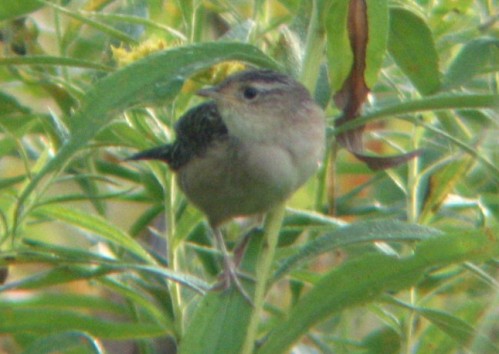 We don’t know if this Sedge Wren is the same individual that we’ve been seeing on and off for the past month, or whether they’re 3 different individuals. Ah, if only it were banded! (Photo by Seabrooke Leckie)- We don’t know if this Sedge Wren is the same individual that we’ve been seeing on and off for the past month, or whether they’re 3 different individuals. Ah, if only it were banded! (Photo by Seabrooke Leckie)-
|
Note: table does not include nocturnal banding (owls).
Bander-in-charge: Seabrooke Leckie Assistants: Veronik Campbell, Sophie Cauchon, Jean Demers, Val Francella, Barbara Frei, Gay Gruner, Bana Hamze, Marie-Anne Hudson, Juliana Lisi, Barbara MacDuff, Sarah Marteinson, Mike Mayerhofer, Betsy McFarlane, Sandra Minotti, Chris Murphy, Andre Pelletier, Katleen Robert, Clemence Soulard
Notes: After the lull of week 5, the 6th week of fall 2006 opened with a bit of excitement. A total of 40 birds were captured, which, while not overwhelming, kept staff on their feet most of the day. The best bird to enter the nets on Tuesday wasn’t banded – the same immature Red-shouldered Hawk that escaped from the nets two weeks ago did it again. One of these days! Other captures (these ones were banded) included a lateish Yellow Warbler, four Rose-breasted Grosbeaks and one of the season’s early Ruby-crowned Kinglets, and a Winter Wren and a Blue-headed Vireo, both new for the season, were recorded on census. In case the hawk wasn’t enough excitement, the third Sedge Wren to be seen at the station was spotted by sharp-eyed volunteers. It’s difficult to say if these sightings have all been the same individual or different ones, or if they might be young from the nearby Arboretum – it’s too bad they seemed to have no interest in the nets!
On Wednesday we were well staffed and were able to open up the full complement of nets for the first time this season. Nearly 60 birds were caught, which included 10 Magnolia Warblers, 5 American Redstart, 5 Wilson’s Warblers and 4 Ovenbirds, as well as a smattering of other species. The first Rusty Blackbirds were seen early in the morning, and two Greater Yellowlegs were heard calling as they flew over the site. The interior of the station received a new floor layout and equipment that has really opened the space up (but you have to see it to believe it!).
North winds overnight on the 7th, along with the sound of the early birds awakening upon arrival at the site, suggested promise for activities for the morning. However, the nets remained about as active as the previous couple of days, as just 43 birds were caught. A large portion of these (12 birds) were Common Grackles captured on one round as a flock came down to rest briefly near some of the nets. The first Blue-headed Vireo banded this fall was captured on Thursday, as well as good numbers of Lincoln’s Sparrows. A hatch-year Common Yellowthroat caught late in the morning was the 1000th bird banded for MBO this season.
Moderate numbers of birds continued to pass through the site on Friday. A large rush on the first round contributed about half of the 38 birds captured for the morning. The majority of these were warblers from a large foraging flock, Philadelphia Vireo, Cedar Waxwings and several Lincoln’s Sparrows. A Scarlet Tanager was among the flock members who avoided the net, and a Northern Parula was spotted on census.
Rain early on the 9th delayed net opening for a couple of hours. The clouds finally cleared enough to allow for a few nets to be opened for the latter half of the morning. A total of 34 birds were banded from just 37 net hours – by far our highest capture rate so far this season. The influx in activity was well-timed, as a group from the COA came out for a demonstration of the MBO operations. The visitors were treated to a good variety of birds as several foraging flocks comprised of warblers, vireos and sparrows were captured. Everyone seemed to thoroughly enjoy the morning, and the extra eyes were of great value as the season’s first Wilson’s Snipe was spotted by the group. MBO gratefully acknowledges the donation from COA as a thank you for the tour.
Sunday dawned cold enough to prompt staff to fire up the wood stove for the first time this season. A similar pattern of activity to Friday occurred, with a large portion of the birds captured on the first net round followed by slow but steady captures the rest of the morning. The season’s first American Pipits were heard flying overhead at opening. The Brown Thrasher that we’d seen escape from the nets on at least two previous occasions this week was finally captured and banded. A female Black-throated Blue Warbler, Traill’s Flycatcher and House Wren were other nice captures rounding out the morning.
The 11th was similarly cold and clear, and brisk north winds overnight the area was noticeably quieter than previous days this week. A total of just 40 species was recorded for the day, our lowest of the week. An influx of Myrtle Warblers was noted in the area, as a total of 15 were recorded for the morning, although only two were captured. Another large flock of Common Grackles was encountered in the nets – a total of 21 were banded, but many more escaped before they could be extracted, to join the very large group perched in the trees beside the nets.
The weekly banding total of 266 birds is our highest so far this season reflecting the increased movement of migrants as we move into the peak of warbler migration. Numbers of sparrows and late-season migrants such as kinglets are just starting to increase, and the weeks to follow are likely to be the most active and most diverse of the season.
This week’s top 10 [last week’s rank in brackets]
| # individuals banded |
mean # individuals observed daily |
| 1. Magnolia Warbler (39) [1] |
American Crow (179) [2] |
| Common Grackle (33) [-] |
Common Grackle (111) [1] |
| Common Yellowthroat (26) [3] |
Black-capped Chickadee (22) [5] |
| Song Sparrow (21) [2] |
Blue Jay (22) [6] |
| Nashville Warbler (18) [7] |
American Goldfinch (21) [4] |
| White-throated Sparrow (13) [-] |
Song Sparrow (20) [3] |
| Tennessee Warbler (9) [7] |
Cedar Waxwing (14) [9] |
| Ovenbird (9) [-] |
Magnolia Warbler (11) [10] |
| Wilson’s Warbler (8) [9] |
White-throated Sparrow (10) [8] |
| Gray Catbird [-] and American Redstart (8) [4] |
Common Yellowthroat (9) [-] |
While numbers were up considerably from last week, the dominant species didn’t change all that much. Common Grackles leapt back to near the top of the banding list, and White-throated Sparrows have made their first appearance of the season there; odds are they will remain on it for the remainder of the fall. For now though, warblers continue to dominate the top ten when it comes to banding. Only a couple of them though were abundant enough to land among the top ten species observed. Crows and grackles continue to dominate that list by a large margin, while Black-capped Chickadee and Blue Jay have climbed into a tie for third place, perhaps indicative of some migration getting underway for these species.
|
 What a week for Common Grackles! Large flocks have been swirling around MBO this week, and we were lucky enough to catch 33 of these monsters. Featured here is a hatch-year male, clearly moulting his juvenal brown feathers for the more elegant iridescent bluish-black look. (Photo by Seabrooke Leckie) What a week for Common Grackles! Large flocks have been swirling around MBO this week, and we were lucky enough to catch 33 of these monsters. Featured here is a hatch-year male, clearly moulting his juvenal brown feathers for the more elegant iridescent bluish-black look. (Photo by Seabrooke Leckie)
|
PICTURE OF THE WEEK
|
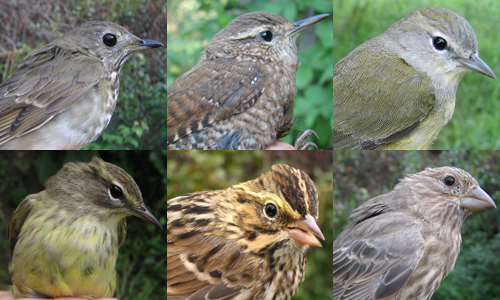 Despite losing our beloved visiting-BIC Seabrooke, this week has been amazing! So amazing, in fact, that we couldn’t narrow the list of “special” pictures to less than 6. These species are all intriguing because we don’t band many of them at MBO. Pictured clockwise from top left are: Gray-cheeked Thrush, Winter Wren, Orange-crowned Warbler, male House Finch, Savannah Sparrow, and Palm Warbler – all of them hatch-year birds! (Photos by Barbara Frei and Marie-Anne Hudson)- Despite losing our beloved visiting-BIC Seabrooke, this week has been amazing! So amazing, in fact, that we couldn’t narrow the list of “special” pictures to less than 6. These species are all intriguing because we don’t band many of them at MBO. Pictured clockwise from top left are: Gray-cheeked Thrush, Winter Wren, Orange-crowned Warbler, male House Finch, Savannah Sparrow, and Palm Warbler – all of them hatch-year birds! (Photos by Barbara Frei and Marie-Anne Hudson)-
|
Note: table does not include nocturnal banding (owls)
| |
THIS WEEK |
THIS FALL |
2006 TOTAL |
SITE TOTAL |
| # birds (and species) banded |
266 (41) |
1430 (64) |
2365 (80) |
7418 (96) |
| # birds (and species) repeat |
54 (18) |
220 (25) |
457 (37) |
1335 (52) |
| # birds (and species) return |
2 (2) |
21 (9) |
118 (22) |
187 (26) |
| # species observed |
75 |
120 |
158 |
180 |
| # net hours |
377.8 |
2869.8 |
5981.6 |
12403.7 |
| # birds banded / 100 net hours |
70.4 |
49.8 |
39.5 |
59.8 |
Banders-in-charge: Seabrooke Leckie, Barbara Frei, Marie-Anne Hudson Assistants: Jean Beaudreault, Veronik Campbell, Natalia Castellanos, Sophie Cauchon, Jacinthe Daprato, Jean Demers, Cheryl Diamond, Val Francella, Helen Garland, Gay Gruner, Gillian Kinsman, Marie-Pier Lambert, Barbara MacDuff, Sarah Marteinson, Mike Mayerhofer, Betsy McFarlane, Chris Murphy, Annie-Claude Paradis, Andr é Pelletier, Limoilou Renaud, Sabrina Richard-Lalonde, Katleen Robert, Clémence Soulard, Katie Sullivan
Notes: This week started out cool and clear with the presence of some small warbler flocks hinting at what was to come. And with the warm sunny weather, the warblers appeared! By the end of the week, we had seen Tennessee, Nashville, Orange-crowned, Yellow, Chestnut-sided, Magnolia, Black-throated Blue, Yellow-rumped, Black-throated Green, Western Palm, Yellow Palm, Blackpoll, Wilson’s, and Black-and-white Warblers, as well as American Redstart, Ovenbird, Northern Waterthrush, and Common Yellowthroat. Saturday through Monday had these little guys positively dripping from the many trees and shrubs around MBO. We just hope it’ll continue for the weeks to come, though we know it’ll have to taper off eventually as they continue their migration southward.
This week saw many species banded for the first time this fall (and no, not all of them were warblers…). These were Savannah Sparrow, Winter Wren, Orange-Crowned Warbler, Yellow Palm Warbler, Gray-cheeked Thrush, and House Finch. We were so excited about these guys that we posted all of their photos above, as we were unable to choose amongst them.
We also managed to add a new species to our observed list, with our first Northern Goshawk of the fall popping up at the end of Chris Murphy’s census, quickly being replaced by an American Kestrel (not new but exciting nonetheless). If only all our raptors were that obliging! While we’re on the subject of raptors, we’ve been noticing an increase in the number of Sharp-shinned and Cooper’s Hawks milling around MBO. Pair those with the 3 Osprey and 4 Turkey Vultures that flew over on Sunday and our resident Red-shouldered Hawks, and the growing gang of American Crows will have plenty of raptors to chase and harass over the coming weeks.
As usual, the week ended with a bang on Monday, with 55 individuals representing 23 species banded, the highest total of both individuals and species this week.
This week’s top 10 [last week’s rank in brackets]
| # individuals banded |
mean # individuals observed daily |
| Yellow-rumped Warbler (49) [-] |
American Crow (244) [1] |
| Nashville Warbler (23) [5] |
Common Grackle (66) [2] |
| Ruby-crowned Kinglet (19) [-] |
American Goldfinch (33) [5] |
| Tennessee Warbler (19) [7] |
Blue Jay (23) [4] |
| Magnolia Warbler (18) [1] |
Black-capped Chickadee (21) [3] |
| White-throated Sparrow (18) [6] |
Song Sparrow (18) [6] |
| Song Sparrow (16) [4] |
Yellow-rumped Warbler (17) [-] |
| Common Yellowthroat (15) [3] |
American Robin (16) [-] |
| American Goldfinch (14) [-] |
White-throated Sparrow (14) [9] |
| Red-eyed Vireo (10) [-] |
Ruby-crowned Kinglet (14) [-] |
This week’s top ten banded species has been turned on its head, with Yellow-rumped Warblers soaring to the number 1 position, and the previously top-rated species, Magnolia Warbler, falling to 5th. Warblers have been so numerous of late, that 4 out of the 5 top species banded are warblers. It would almost be possible to get away with saying that the top 5 species are warblers, as the only odd one out, the Ruby-crowned Kinglet, is often mistaken for one!
Alright… we’ll stop talking about warblers now…
|
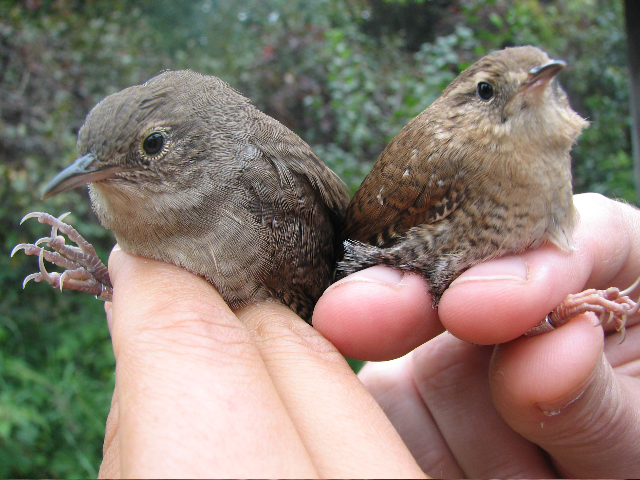 We love nothing more than showing the differences between species, and nothing makes it easier than getting a side-by-side shot. It certainly was considerate of this House Wren and this Winter Wren to enter the nets on the same net round! In this case the key differences, colour and tail length, are made vividly clear. The House Wren is larger, a mousey brown with a (relatively) long tail. The Winter Wren is smaller, with a richer, more rusty colour, and a stubby little tail. (Photo by Barbara Frei) . We love nothing more than showing the differences between species, and nothing makes it easier than getting a side-by-side shot. It certainly was considerate of this House Wren and this Winter Wren to enter the nets on the same net round! In this case the key differences, colour and tail length, are made vividly clear. The House Wren is larger, a mousey brown with a (relatively) long tail. The Winter Wren is smaller, with a richer, more rusty colour, and a stubby little tail. (Photo by Barbara Frei) .
|
Week 8: September 19-25, 2006
PICTURE OF THE WEEK
|
 A surprising species in this week’s top ten: Black-throated Green Warbler! Although they are not as showy in basic plumage as they are during the breeding season, their olive-green backs and bright yellow cheeks add a splash of colour to fall. (Photo by Barbara Frei)- A surprising species in this week’s top ten: Black-throated Green Warbler! Although they are not as showy in basic plumage as they are during the breeding season, their olive-green backs and bright yellow cheeks add a splash of colour to fall. (Photo by Barbara Frei)-
|
| |
THIS WEEK |
THIS FALL |
2006 TOTAL |
SITE TOTAL |
| # birds (and species) banded |
332 (33) |
1762 (67) |
2697 (80) |
7750 (96) |
| # birds (and species) repeat |
29 (12) |
249 (31) |
486 (38) |
1364 (52) |
| # birds (and species) return |
— |
21 (9) |
118 (22) |
187 (26) |
| # species observed |
78 |
122 |
159 |
180 |
| # net hours |
175.3 |
3045.1 |
6156.9 |
12579.0 |
| # birds banded / 100 net hours |
189.3 |
57.9 |
43.8 |
61.6 |
Note: table does not include nocturnal banding (owls)
Banders-in-charge: Marie-Anne Hudson, Barbara Frei Assistants: Martin Bowman, Sophie Cauchon, Alejandro del Peral, Jean Demers, Val Francella, Helen Garland, Gay Gruner, Bana Hamze, Barbara MacDuff, Don MacDuff, Sarah Marteinson, Poonam Maskeri, Mike Mayerhofer, Betsy McFarlane, Chris Murphy, Daniel Oyama, Annie-Claude Paradis, André Pelletier, Katleen Robert, Clémence Soulard, Katie Sullivan, Sandra Warren, Marie-Claude, Josée
Notes: For those of you who had any doubts as to what time of year it is, let us assure you, it’s migration time! Despite the cooler mornings (don’t worry, it’s cozy inside the banding station thanks to our wood stove), bird activity is incredible! The low number of net hours for the week hints at the week we’ve had: nets had to be closed early on most days since there were not enough extractors to deal with the number of birds caught! The guilty parties were mostly the ubiquitous Yellow-rumped Warblers that seem to be absolutely everywhere. A new net line, H2, was installed this week and broke records when it caught 49 birds within 25 minutes Monday morning. It was a sight to see, as warblers lay side by side calmly waiting to be extracted.
Other birds of note were the season’s first banded and seen Golden-crowned Kinglet, and Eastern White-crowned Sparrow. As well, four Scarlet Tanagers – always a nice bird to see up close instead of flitting in the treetops – were caught side-by-side on Sunday morning… in H2 of course.
|
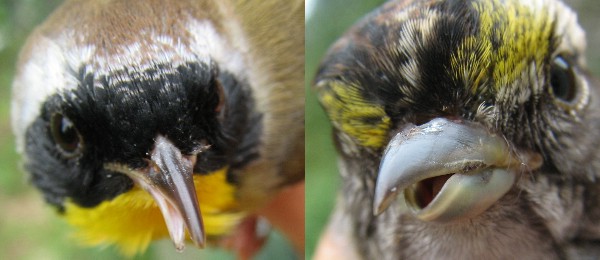 We had two candidates for the new ‘oddities’ page that we are putting together, which displays the strange things that can be encountered while banding. These ‘cross-billed’ individuals – a Common Yellowthroat and White-throated Sparrow – were both fat and seemingly healthy adults! They seem to have survived well despite their challenges – or perhaps have even found a way to benefit from them. (Photos by Barbara Frei) . We had two candidates for the new ‘oddities’ page that we are putting together, which displays the strange things that can be encountered while banding. These ‘cross-billed’ individuals – a Common Yellowthroat and White-throated Sparrow – were both fat and seemingly healthy adults! They seem to have survived well despite their challenges – or perhaps have even found a way to benefit from them. (Photos by Barbara Frei) .
|
This week’s top 10 [last week’s rank in brackets]
| # individuals banded |
mean # individuals observed daily |
| Yellow-rumped Warbler (163) [1] |
American Crow (244) [1] |
| Ruby-crowned Kinglet (42) [3] |
Canada Goose (156) [-] |
| Magnolia Warbler (15) [5] |
Common Grackle (84) [2] |
| Nashville Warbler (15) [2] |
Yellow-rumped Warbler (75) [7] |
| White-throated Sparrow (14) [6] |
American Robin (32) [8] |
| Black-throated Green Warbler (11) [-] |
Ruby-crowned Kinglet (30) [10] |
| Song Sparrow (10) [7] |
Rusty Blackbird (24) [-] |
| Common Yellowthroat (6) [8] |
Blue Jay (24) [4] |
| Lincoln’s Sparrow (5) [-] |
Red-winged Blackbird (20) [-] |
| Golden-crowned Kinglet (4) [-] |
White-throated Sparrow (18) [9] |
Out of the top ten species banded, there are 5 warbler species, both species of kinglets and 3 species of sparrows. No surprise to anyone who has been out this week! We are fairly certain that most of our student volunteers can now confidently recognize, and it many cases sex our top 2 species – Yellow-rumped Warblers and Ruby-crowned Kinglets – as they had plenty of opportunity to see them up close. As for the daily observations, American Crows still gathered and streamed by in impressive numbers, making them the top species observed. The coming fall has been echoed every morning with the sounds of the growing flocks of Canada Geese making their way towards warmer weather. As well, blackbird migration is taking place, the most exciting being Rusty Blackbird sightings on multiple days this week. And of course, the energetic Ruby-crowned Kinglets and Yellow-rumped Warblers are dripping from every bush – delighting everyone with their presence. The top 10 species alone accounted for an average of over 700 birds observed each day this week!
|
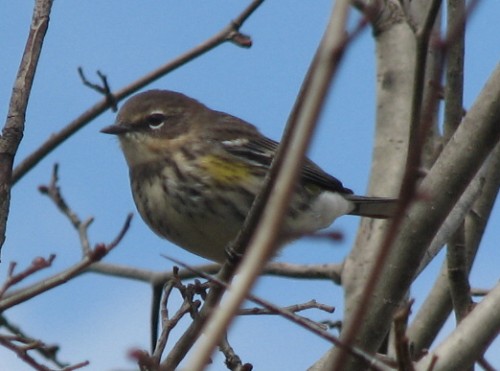 A bird in the hand may be worth two in the bush – but I don’t know – there were a LOT of Yellow-rumped Warblers in the bushes around MBO! With 49 caught Friday, 27 Sunday, and 48 Monday (with very few recaptures) you have to wonder – how many are out there? Well, since they are one of our target boreal birds, the more the merrier! (Photo by Barbara Frei) . A bird in the hand may be worth two in the bush – but I don’t know – there were a LOT of Yellow-rumped Warblers in the bushes around MBO! With 49 caught Friday, 27 Sunday, and 48 Monday (with very few recaptures) you have to wonder – how many are out there? Well, since they are one of our target boreal birds, the more the merrier! (Photo by Barbara Frei) .
|
Week 9: September 26 – October 2, 2006
PICTURE OF THE WEEK
|
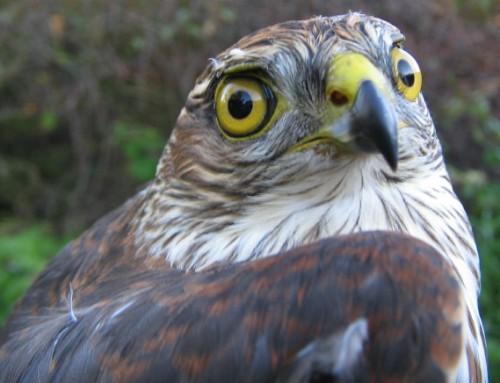 This hatch-year male Sharp-shinned Hawk added further excitement to a record-breaking week. (Photo by Marie-Anne Hudson)- This hatch-year male Sharp-shinned Hawk added further excitement to a record-breaking week. (Photo by Marie-Anne Hudson)-
|
|
| |
THIS WEEK |
THIS FALL |
2006 TOTAL |
SITE TOTAL |
| # birds (and species) banded |
545 (35) |
2307 (70) |
3242 (82) |
8295 (96) |
| # birds (and species) repeat |
48 (10) |
297 (32) |
534 (38) |
1412 (52) |
| # birds (and species) return |
2 (1) |
23 (9) |
120 (22) |
189 (26) |
| # species observed |
71 |
125 |
159 |
180 |
| # net hours |
208.9 |
3254.0 |
6365.8 |
12787.9 |
| # birds banded / 100 net hours |
260.9 |
70.9 |
50.9 |
64.8 |
Note: table does not include nocturnal banding (owls)
Banders-in-charge: Marie-Anne Hudson, Barbara Frei Assistants: Laura Balanoff, Sophie Cauchon, Dominic Chambers, Jacinthe Daprato, Jean Demers, Val Francella, Marcel Gahbauer, Helen Garland, Gay Gruner, Gillian Keurman, Lance Laviolette, Sarah Marteinson, Betsy McFarlane, Laurie Maurias, Mike Mayerhofer, Anthi Mimidakis, Julia Mlynarek, Chris Murphy, Annie-Claude Paradis, André Pelletier, Limoilou Renaud, Sabrina Richard-Lapland, Katleen Robert, Luke Scott, Clémence Soulard
Notes: This was, without a doubt, the busiest week of the season thus far – and in fact the busiest in the history of MBO! And before I say anything more I want to thank all the volunteers this week for their hard work and dedication! We would not have been able to pull off some of our crazy days without your help. So give yourselves a big pat on the back.
The Yellow-rumped Warblers were by far still the most numerous birds banded this week, with a record 71 individuals banded out of 88 birds on Tuesday, September 26th. Over the course of this one week, more of them were banded than in the entire 2004 and 2005 migrations combined! But by the second half of the week it was clear that Ruby-crowned Kinglets and sparrows would soon take over as the top species, as the Yellow-rumped Warblers begin to slowly taper off toward the end of their migration period.
The number of birds banded steadily increased as the week went on to a record breaking day on Saturday with 152 individuals banded (23 species) followed by a very busy Monday with 129 individuals (21 species). Some of this week’s highlights include, 1 Sharp-shinned Hawk, 4 Hermit Thrushes, 1 Chestnut-sided Warbler, 1 Savannah Sparrow, 2 Philadelphia Vireos and 1 Orange-crowned Warbler. Any of course many, many more!
This week’s top 10 [last week’s rank in brackets]
| # individuals banded |
mean # individuals observed daily |
| Yellow-rumped Warbler (236) [1] |
Canada Goose (251) [2] |
| Ruby-crowned Kinglet (114) [2] |
American Crow (126) [1] |
| White-throated Sparrow (57) [5] |
Yellow-rumped Warbler (76) [4] |
| White-crowned Sparrow (27) [-] |
Ruby-crowned Kinglet (42) [6] |
| Golden-crowned Kinglet (17) [10] |
White-throated Sparrow (32) [10] |
| Song Sparrow (13) [7] |
American Robin (31) [5] |
| Nashville Warbler (10) [4] |
Blue Jay (19) [7] |
| Gray Catbird (8) [-] |
White-crowned Sparrow (18) [-] |
| Magnolia Warbler (8) [3] |
Black-capped Chickadee (16) [-] |
| Cedar Waxwing (6) [-] |
Song Sparrow (15) [-] |
A distinct shift has occurred in this week’s top 10 banded — the warblers are becoming less numerous (except the Yellow-rumped of course!) as sparrow and kinglet numbers are climbing. Most mornings at MBO are filled with the somewhat less than melodious attempted songs and chirps of young White-throated and Eastern White-crowned Sparrows – the latter much more numerous than they usually are here. Ruby-crowned Kinglets, often curiously watching the volunteers as they walk the net lines, are beginning to gather in large numbers, as seen this Monday morning with 57 banded that day alone.
The top ten species observed also reflect these changes, with the three sparrow species, Ruby-crowned Kinglets and Yellow-rumped Warblers all making the top ten. The Canada Geese are continuing their migration and will likely be near the top spot for some time to come. American Robins, Blue Jays, and Black-capped Chickadees continue to be common sightings in the area, though the chickadees are nowhere near as abundant as they were at this time last fall.
|
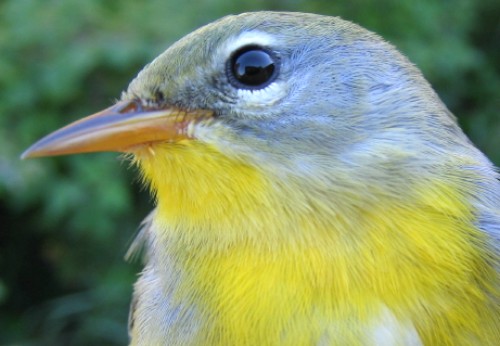 While Yellow-rumped Warblers dominated the nets this week, a number of other warbler species were banded in smaller numbers, including (at last) our first Northern Parula of the Fall 2006 season. (Photo by Barbara Frei) While Yellow-rumped Warblers dominated the nets this week, a number of other warbler species were banded in smaller numbers, including (at last) our first Northern Parula of the Fall 2006 season. (Photo by Barbara Frei)
border=”0″ src=”/wp-content/mbophotos/06fa09_BCCH.jpg” width=”305″ height=”229″> A pictorial reminder to regularly check bird bags for holes … especially if you put a Black-capped Chickadee inside! This little one was just able to poke his head out, but luckily did not escape. (Photo by Barbara Frei).
|
Week 10: October 3-9, 2006
PICTURE OF THE WEEK
|
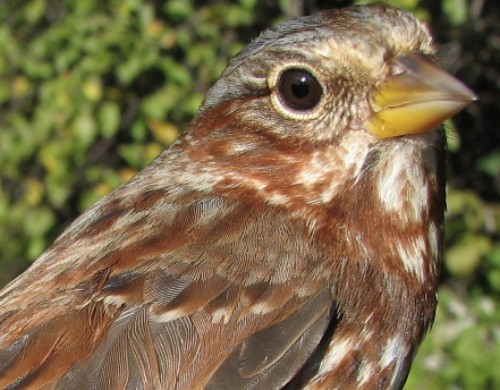 This week, species banded for the first time this season included Brown Creeper and the Fox Sparrow shown above. This is among the few species that is likely to become increasingly common over the final three weeks of the season, usually dominated by American Robins and a variety of sparrow species. (Photo by Barbara Frei)- This week, species banded for the first time this season included Brown Creeper and the Fox Sparrow shown above. This is among the few species that is likely to become increasingly common over the final three weeks of the season, usually dominated by American Robins and a variety of sparrow species. (Photo by Barbara Frei)-
|
|
| |
THIS WEEK |
THIS FALL |
2006 TOTAL |
SITE TOTAL |
| # birds (and species) banded |
305 (23) |
2612 (72) |
3547 (82) |
8600 (96) |
| # birds (and species) repeat |
26 (11) |
323 (33) |
560 (39) |
1438 (52) |
| # birds (and species) return |
1 (1) |
24 (9) |
121 (22) |
190 (26) |
| # species observed |
65 |
131 |
159 |
180 |
| # net hours |
333.3 |
3587.3 |
6699.1 |
13121.2 |
| # birds banded / 100 net hours |
91.5 |
72.8 |
52.9 |
65.5 |
Note: table does not include nocturnal banding (owls)
Bander-in-charge: Barbara Frei Assistants: Nadege Allan, Jean Beaudreault, Sophie Cauchon, Dominic Chambers, Natalia Costella, Jacinthe Daprato, Alejandro Del Peral, Jean Demers, Maria Frei, Gay Gruner, Amy Henderson, Keelan Jacobs, Marie-Pier Lambert, Sarah Marteinson, Poonam Maskeri, Laurie Maurias, Mike Mayerhofer, Betsy McFarlane, Anthi Mimidakis, Chris Murphy, Annie-Claude Paradis, André Pelletier, Greg Rand, Sabrina Richard-Lapland, Katleen Robert, Marie-Claude Roy, Clémence Soulard, Katie Sullivan, Rachel Verkade, James Young
Notes: This week was slower in bird activity than the past week. Several mornings were rather frosty, leading to some stiff and frozen nets and fingers. The busiest day was a very foggy Wednesday morning (4th Oct.) with 109 birds banded from just two net lines. This was due to a large wave of Ruby-crowned Kinglets, which resulted in them overtaking Yellow-rumped Warblers as the most frequently banded species of the week.
Despite the lower number of birds banded there were 6 new species sighted in Week 10. These included the previously mentioned Brown Creepers and Fox Sparrows banded this week. In addition, a Rough-legged Hawk was seen soaring above late Wednesday morning once the skies cleared. Early Thursday morning a Snow Goose was spotted among one of the growing Canada Goose flocks. It was distinguished from the surrounding Canada Geese by its smaller size and lighter body with dark tipped wings. As well, during the Thursday census a lone Eastern Bluebird was heard singing its bittersweet farewell amongst the rowdier chatter of American Robins. Lastly, a curious juvenile Northern Shrike supervised the de-frosting of the A net on a the chilly Saturday morning – but despite our most polite invitation it did not enter the net once it was opened. Perhaps next time!
|
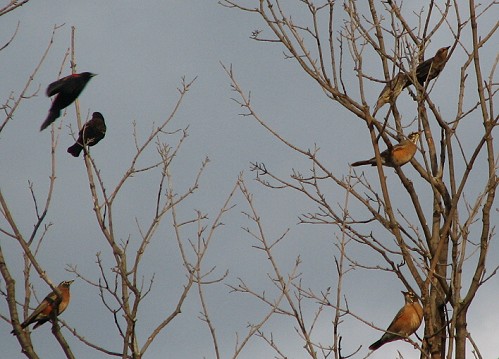 It seems there are always birds in the large dead tree near the north end of Stoneycroft Pond, and it’s always a good idea to look closely at them for potential surprises. Can you spot the four species in the photo above? Answer at the end of this week’s report. (Photo by Barbara Frei) It seems there are always birds in the large dead tree near the north end of Stoneycroft Pond, and it’s always a good idea to look closely at them for potential surprises. Can you spot the four species in the photo above? Answer at the end of this week’s report. (Photo by Barbara Frei)
|
With the ripening of the buckthorn berries and wild grapes on site has come the time of the American Robins, whose chatters and songs fill the morning air. Several found their way into the nets and dyed both our bags and volunteers hands a rather lovely shade of blue with their berry-filled droppings. Their smaller and infinitely better behaved cousin, the Hermit Thrush, was also a welcome visitor most mornings. A surprise in this week’s top 10 banded is the Winter Wren. These little songsters are often tricky to see, so it’s a treat to have a good number of them in the nets this week.
This week’s top 10 [last week’s rank in brackets]
| # individuals banded |
mean # individuals observed daily |
| 1. Ruby-crowned Kinglet (115) [2] |
Canada Goose (376) [1] |
| Yellow-rumped Warbler (40) [1] |
American Robin (99) [6] |
| White-throated Sparrow (31) [3] |
American Crow (67) [2] |
| American Robin (28) [-] |
Red-winged Blackbird (57) [-] |
| White-crowned Sparrow (17) [4] |
Ruby-crowned Kinglet (49) [4] |
| Song Sparrow (10) [6] |
White-throated Sparrow (25) [5] |
| Hermit Thrush (10) [-] |
Yellow-rumped Warbler (25) [3] |
| Golden-crowned Kinglet (7) [5] |
Blue Jay (23) [7] |
| Swamp Sparrow (7) [-] |
Common Grackle (22) [-] |
| WINTER Wren (6) [-]Black-capped Chickadee (17) [9] |
At this point last year, White-throated Sparrows had been on top of the list of most frequently banded birds for four consecutive weeks. This year they are much less abundant, consistently within the top five, but never yet cracking the top two – are they just late, have they been passing MBO by this year, or did they have a poor breeding season compared to 2005? Questions such as these are difficult to answer at this point, but once we have several more years of consistent monitoring behind us, yearly fluctuations and population trends should become more apparent.
The top 6 species from last week’s banding list remained in this week’s top 10, while the American Robin vaulted into fourth place and will likely remain among the most abundant species over the final three weeks of the season. White-crowned Sparrows continue to be surprisingly numerous, with more banded in the past two weeks (44) than in the cumulative history of MBO to this point (39).
The Canada Geese dominated this week’s list of top 10 seen. in addition to a substantial increase in American Robin numbers, a big change from last week is the growing number of Red-winged Blackbird flocks passing through. They rarely if ever come low enough to be caught in the nets in the fall – but they often land in some of the larger trees in the property, causing a competition for space and sound with the feeding American Robins. And it’s often worth to take a closer look at these groups, for many days this week we were able to spot several Rusty Blackbirds among them.
|
 The confusing fall warblers may be largely past us at this point, but this does not mean there are no challenges remaining. Sparrows are often regarded as a confusing bunch – more so when they do not look as expected. The large sparrow above has tricked many. However, if you look closely at the bill and facial pattern, it is very similar to that of the bird below, easily recognizable as a White-crowned Sparrow. In fact, while the plumage above can be confusing at first, its distinctiveness makes this the easiest of the sparrows for which to distinguish between hatch-year (above) and after-hatch-year (below) birds. (Photos by Marcel Gahbauer) The confusing fall warblers may be largely past us at this point, but this does not mean there are no challenges remaining. Sparrows are often regarded as a confusing bunch – more so when they do not look as expected. The large sparrow above has tricked many. However, if you look closely at the bill and facial pattern, it is very similar to that of the bird below, easily recognizable as a White-crowned Sparrow. In fact, while the plumage above can be confusing at first, its distinctiveness makes this the easiest of the sparrows for which to distinguish between hatch-year (above) and after-hatch-year (below) birds. (Photos by Marcel Gahbauer)
 Occasionally, there are hatch-year White-crowned Sparrows that are already showing a bit of white and black in their crown, like the individual below captured this week. (Photo by Barbara Frei) Occasionally, there are hatch-year White-crowned Sparrows that are already showing a bit of white and black in their crown, like the individual below captured this week. (Photo by Barbara Frei)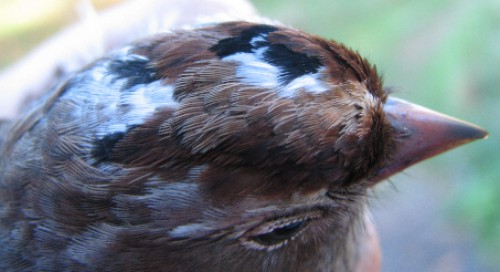
Answer to the 4-species photo: 2 Red-winged Blackbirds (top left, one showing its red shoulder patch), 3 American Robins (all easily spotted by their orange breasts), 1 Rusty Blackbird (top right, with a visibly brown tone, especially around the face, and the yellow eye barely showing), and 1 Cedar Waxwing (a streaky hatch-year bird just below and to the left of the Rusty Blackbird): 
|
Week 11: October 10-16, 2006
PICTURE OF THE WEEK
|
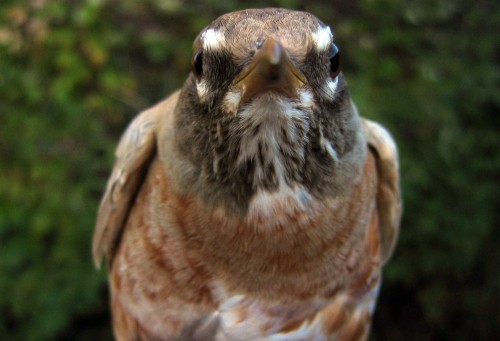 Here’s lookin’ at you, kid… Or at least that what we think this pale American Robin was saying as it posed for us Monday morning. While it wasn’t leucistic or albino, this bird is definitely different! (Photo by Gay Gruner) Here’s lookin’ at you, kid… Or at least that what we think this pale American Robin was saying as it posed for us Monday morning. While it wasn’t leucistic or albino, this bird is definitely different! (Photo by Gay Gruner)
|
| |
THIS WEEK |
THIS FALL |
2006 TOTAL |
SITE TOTAL |
| # birds (and species) banded |
241 (22) |
2853 (74) |
3788 (83) |
8841 (96) |
| # birds (and species) repeat |
49 (10) |
372 (36) |
609 (39) |
1487 (52) |
| # birds (and species) return |
2 (1) |
26 (9) |
123 (22) |
192 (26) |
| # species observed |
61 |
134 |
159 |
180 |
| # net hours |
310.3 |
3897.6 |
7009.4 |
13431.5 |
| # birds banded / 100 net hours |
77.7 |
73.2 |
54.0 |
65.8 |
Note: table does not include nocturnal banding (owls)
Bander-in-charge: Marie-Anne Hudson, Barbara Frei Assistants: Jean Beaudrault, Dan Brown, Veronik Campbell, Sophie Cauchon, Natalia Castelanos, Alejandro Del Peral, Jean Demers, Emilie Dion, David Fishman, Marcel Gahbauer, Gay Gruner, Kanako Hasegawa, Amy Henderson, Sabrina Lalande, Barbara MacDuff, Laurie Maurais, Betsy McFarlane, Chris Murphy, Gillian Murphy, Ian Niu, Annie-Claude Paradis, André Pelletier, Limoilou Renaud, Clémence Soulard, Rachel Verkade
Notes: This week was noticeably slower than the last few, allowing us the opportunity to tinker with our net set-up and the ever-present J-trap. The product: an operational J-trap, and two nets that have been largely unused this fall due to their distance from the banding season have been moved closer, adding an additional net to each of A and E. So far the nets appear to be working quite nicely, but the J-trap has yet to catch anything. It’ll likely be a while before the birds realize that we’ve laid out a bounty of food for them, but that’s alright. We’re a patient bunch.
If one species were to characterize the week, it would certainly be the American Robin. They arrived ‘en masse’ at the beginning of the week, with a peak of roughly 1500 on Sunday. They have been concentrating in the tall cottonwoods lining B (unfortunately – or fortunately – closed due to excessive leaf-fall along there), but have also been steadily streaming south high above the site. It’s quite spectacular to hear them begin squawking away as the sun rises, only to fall silent as a Cooper’s Hawk or Merlin flies by.
|
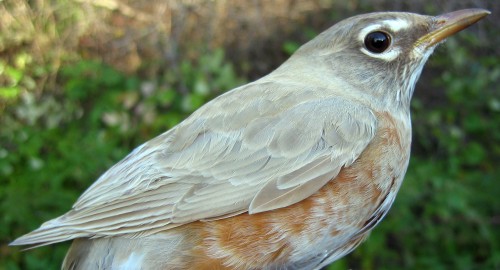 A side view of this week’s unusually pale American Robin (Photo by Gay Gruner) A side view of this week’s unusually pale American Robin (Photo by Gay Gruner)
|
This week’s newly-banded species include Hairy Woodpecker (a long time coming) and House Sparrow. It seems that these little guys disappear for a while after the breeding season, only to come back in time for our winter feeder nets. Newly sighted species for the season include American Tree Sparrow — a sure sign that winter is on its way — Pine Siskin and Cackling Goose.
This week’s top 10 [last week’s rank in brackets]
| # individuals banded |
mean # individuals observed daily |
| 1. American Robin (82) [4] |
American Robin (419) [2] |
| Ruby-crowned Kinglet (71) [1] |
Canada Goose (233) [1] |
| Golden-crowned Kinglet (15) [8] |
Red-winged Blackbird (132) [4] |
| Hermit Thrush (14) [7] |
American Crow (131) [3] |
| White-throated Sparrow (13) [3] |
Ruby-crowned Kinglet (41) [5] |
| Yellow-rumped Warbler (6) [2] |
Cedar Waxwing (31) [-] |
| Song Sparrow (6) [6] |
Mallard (27) [-] |
| Blue Jay (5) [-] |
European Starling (27) [-] |
| Slate-colored Junco (5) [-] |
White-throated Sparrow (21) [6] |
| White-crowned Sparrow (4) [5], Orange-crowned Warbler (4) [-] |
Blue Jay (20) [8] |
This week’s banding top ten is dominated by two species: American Robin and Ruby-crowned Kinglet, which is no surprise to anyone who’s been on-site over the past few days. The robin peak is right on schedule, as the largest flocks passed between October 14 and 19 last year as well. The top ten sighted species are relatively similar to those of last week, with the exception of Cedar Waxwing, European Starling and Mallard making an appearance. It’s anyone’s guess as to who will occupy the same spots next week, though we anticipate a big push of Slate-coloured Juncos to arrive soon, along with increasing numbers of American Tree and Fox Sparrows.
|
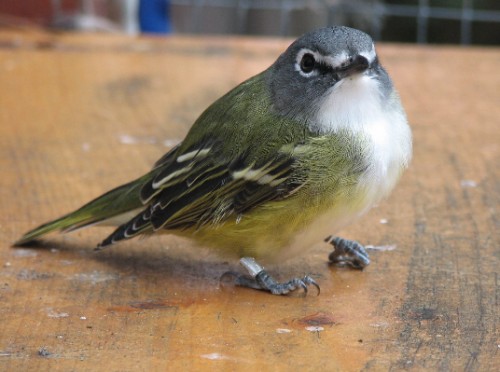 It’s rare to get such a clear shot of a vireo, but this little guy posed quite nicely for us while deciding where to fly after being released. Notice the band? (Photo by Barbara Frei) It’s rare to get such a clear shot of a vireo, but this little guy posed quite nicely for us while deciding where to fly after being released. Notice the band? (Photo by Barbara Frei)
|
Week 12: October 17-23, 2006
PICTURE OF THE WEEK
|
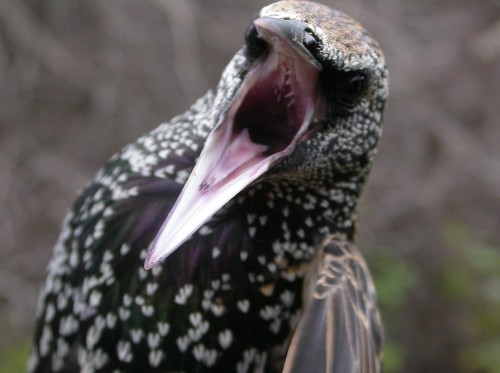 This young European Starling gave us its impression of a Common Nighthawk, opening its mouth larger than we ever thought possible! We suppose it was excited that it was only the third starling ever to be banded at MBO. (Photo by Marcel Gahbauer) This young European Starling gave us its impression of a Common Nighthawk, opening its mouth larger than we ever thought possible! We suppose it was excited that it was only the third starling ever to be banded at MBO. (Photo by Marcel Gahbauer)
|
Note: table does not include nocturnal banding (owls)
| |
THIS WEEK |
THIS FALL |
2006 TOTAL |
SITE TOTAL |
| # birds (and species) banded |
321 (19) |
3174 (76) |
4109 (84) |
9162 (96) |
| # birds (and species) repeat |
33 (9) |
405 (36) |
642 (39) |
1520 (52) |
| # birds (and species) return |
2 (2) |
28 (10) |
125 (22) |
194 (26) |
| # species observed |
55 |
134 |
159 |
180 |
| # net hours |
318.3 |
4215.9 |
7327.7 |
13749.8 |
| # birds banded / 100 net hours |
100.8 |
75.3 |
56.1 |
66.6 |
Banders-in-charge: Marie-Anne Hudson, Barbara Frei, Marcel Gahbauer Assistants: Nadege Allan, Laura Balanoff, Jean Beaudrault, Sophie Cauchon, Natalia Castelanos, Jean Demers, Emilie Dion, Val Francella, Josée Girard, Gay Gruner, Kanako Hasegawa, Sabrina Lalande, Marie-Pier Lambert, Barbara MacDuff, Sarah Marteinson, Betsy McFarlane, Chris Murphy, Ian Niu, André Pelletier, Katleen Robert, Marie-Claude Roy, Luke Scott, Clémence Soulard
Notes: This week we lost two days to rain, but still managed to break 300 birds banded. This is likely due to the 109-bird day we had Tuesday morning (half of them American Robins!), indicating that migration is still going strong for some species. In addition, we broke the 3000 birds banded mark for our Fall 2006 season! This is triple the number of birds banded in spring 2006 and brings the site total to over 9000 birds.
Even this far into our fall season (the penultimate week), we managed to find two new species to band. One of these species has been very successful in avoiding our nets, as it generally remains in large raucous flocks high above the site. We’re talking about the European Starling, a non-native species that we have to admit we were very excited to band. The second new species, the American tree Sparrow, is actually in the top ten this week, indicating that they’re indeed on the move. An honourable mention goes to our second fall Red-winged Blackbird that hit the net one round after the starling, making for a very exciting Saturday morning (…a third Red-winged Blackbird the following morning was slightly anticlimactic, but still welcomed by all who were present!). This highlights the difference a season can make: we would have hardly been this excited had a Red-winged Blackbird hit our nets in spring, as it was by far the most commonly banded species of the season.
Species diversity is on the decline as winter approaches, with the 55 species seen over the course of this week not even as many as the best single-day totals from earlier in the season. However, heading out late in the season has its own rewards, as those who volunteered on the weekend appreciated. On Saturday, the cold and blustery northwest winds brought with them a steady supply of raptors including 21 Red-tailed Hawks and smaller numbers of Sharp-shinned, Cooper’s, and Rough-legged Hawks, as well as Northern Harriers and Turkey Vultures. Then on Sunday, 3 beautiful Eastern Bluebirds decided to hang out in the hawthorns between the V and A nets for a couple of hours, giving everyone a great view of these rather uncommon visitors.
We also had a nice reminder this week of why winter banding is so important: we recaptured an adult male Slate-colored Junco that we had previously banded around our feeders last February. It’s amazing to think that this bird traveled the same path it took last year – opting to fuel up at our tiny little site far removed from his boreal breeding grounds. We’re happy to report that he was in great shape. We wish him the best of luck as he makes his way south, and hope he visits us again this spring … or again hangs around to enjoy the benefits of our winter feeders!
|
 This after-hatch-year male Slate-colored Junco returned to us after having been banded last February during the winter banding season. Thanks to André Pelletier (plus camera) for his determined pursuit of released birds. It’s always nice to see them perched comfortably post-release. (Photo by André Pelletier). This after-hatch-year male Slate-colored Junco returned to us after having been banded last February during the winter banding season. Thanks to André Pelletier (plus camera) for his determined pursuit of released birds. It’s always nice to see them perched comfortably post-release. (Photo by André Pelletier).
|
This week’s top 10 [last week’s rank in brackets]
| # individuals banded |
mean # individuals observed daily |
| 1. American Robin (143) [1] |
American Robin (321) [1] |
| Ruby-crowned Kinglet (57) [2] |
Red-winged Blackbird (174) [3] |
| Golden-crowned Kinglet (28) [3] |
European Starling (169) [8] |
| White-throated Sparrow (19) [5] |
American Crow (152) [4] |
| Slate-coloured Junco (15) [9] |
Canada Goose (78) [2] |
| American Tree Sparrow (14) [-] |
White-throated Sparrow (24) [9] |
| Song Sparrow (13) [7] |
Cedar Waxwing (23) [8] |
| Hermit Thrush (8) [4] |
Ruby-crowned Kinglet (20) [5] |
| Yellow-rumped Warbler (6) [6] |
Mallard (17) [7] |
| Blue Jay (3) [8], Swamp Sparrow (3) [-] |
Blue Jay (14) [10] |
This week’s top ten is much like last week’s, indicating a stabilization in species diversity as migration begins to slow. As most of the warblers are now down south, we now find mostly sparrows, robins and blackbirds hopping around the site or in the nets. Canada Geese finally are dropping down the list this week, relinquishing the hold they’ve had near the top since their appearance approximately one month ago. The Ruby-crowned Kinglet is also slowly dropping out of the top ten observed species list – although a mid-week influx propelled them and their cousins (Golden-crowned Kinglet) to second and third most frequently banded species for the week. Winter’s definitely on its way though, as these increasingly chilly mornings remind us, so we’re busy preparing for our winter season before the fall nets have even come down.
A second wave of Yellow-rumped Warblers pushed its way through mid-week, once again placing them in the top ten despite being almost completely absent the rest of the week. It seemed to be the week for day-long waves, with 400 Red-winged Blackbirds on Friday, and 700-odd European Starlings flocking around on Saturday, largely accounting for their jump in the weekly totals. The only consistent species has been the American Robin, holding steady at around 300 per day.
|
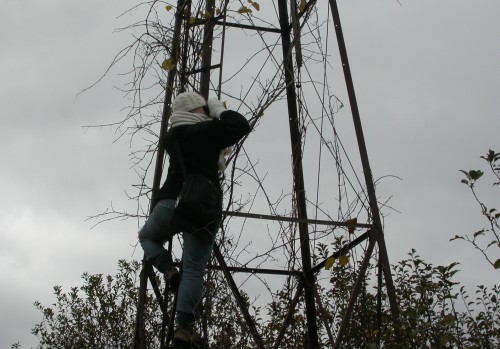 Marie-Anne just HAD to get a better look at the passing raptors. Too bad they were gone by the time she scrambled up the windmill. (Photo by Marcel Gahbauer) Marie-Anne just HAD to get a better look at the passing raptors. Too bad they were gone by the time she scrambled up the windmill. (Photo by Marcel Gahbauer)
|
Week 13: October 24-30, 2006
PICTURE OF THE WEEK
|
 The highlight of our final week of the 2006 fall season was this after-hatch-year male Indigo Bunting, banded on Friday morning. That date was over three weeks later than that of the latest individual in 2005, and even that one was considered to be unusually delayed in its migration. However, this bird was in great condition, carrying more fat than any other bird banded the rest of the morning. (Photo by Marcel Gahbauer) The highlight of our final week of the 2006 fall season was this after-hatch-year male Indigo Bunting, banded on Friday morning. That date was over three weeks later than that of the latest individual in 2005, and even that one was considered to be unusually delayed in its migration. However, this bird was in great condition, carrying more fat than any other bird banded the rest of the morning. (Photo by Marcel Gahbauer)
|
| |
THIS WEEK |
THIS FALL |
2006 TOTAL |
SITE TOTAL |
| # birds (and species) banded |
94 (11) |
3268 (76) |
4203 (84) |
9256 (96) |
| # birds (and species) repeat |
8 (3) |
413 (37) |
650 (39) |
1528 (52) |
| # birds (and species) return |
3 (2) |
31 (10) |
128 (22) |
197 (26) |
| # species observed |
50 |
134 |
159 |
180 |
| # net hours |
207.0 |
4422.9 |
7534.7 |
13956.8 |
| # birds banded / 100 net hours |
45.4 |
73.9 |
55.8 |
66.3 |
Note: table does not include nocturnal banding (owls)
Banders-in-charge: Marie-Anne Hudson, Barbara Frei, Marcel Gahbauer Assistants: Jean Beaudreault, Sophie Cauchon, Shawn Craik, Jean Demers, Emilie Dion, David Fishman, Raphaël Goulet, Gay Gruner, Meggy Hervieux, Gillian Kinsman, Louis-Phillipe Lafrance, Steve Leckman, Barbara MacDuff, Sarah Marteinson, Jennifer MacWilliams, Mike Mayerhofer, Betsy McFarlane, Chris Murphy, André Pelletier, Limoilou Renaud, Katleen Robert, Emilie Roy-Dufresne, Clémence Soulard, Stephanie Steeves, Rachel Verkade
Notes: It is with a bittersweet feeling that we end our 2006 Fall Migration Monitoring Program at McGill Bird Observatory. It has been another very good season, with plenty of noteworthy moments and memories along the way. So, as much as we’ll all enjoy being able to sleep in until (considerably) after dawn, we’ll miss the many birds and people we’ve become used to seeing on such a regular basis. We hope that in spring we can welcome back not only some of the many birds we’ve observed over the past three months, but also many of the great volunteers who played such an important role in making this season another resounding success.
Unfortunately the weather over the final week was rather unpleasant, with plenty of wind, rain, and cold temperatures resulting in two days of closed nets and two more with highly reduced net hours. This led to a rather low weekly banded total of only 94 birds.
While the weather was less than ideal most days, the worst was saved for the weekend. After a second half of October that was already wetter than usual, Saturday brought another 43 mm of rain, putting net H1 back under the floodline, and creating deep pools along many of the trails. Then on Sunday Mother Nature was particularly thorough, dispensing a mix of rain, drizzle, freezing rain, ice pellets, and wet snow throughout the morning, often several types within a few minutes of each other! All this was accompanied by a brisk wind that began around 45 km/h and escalated to 60 by noon, with gusts to over 90. Obviously banding was out of the question, but surprisingly there were a lot of birds to be observed, including plenty of late-migrating kinglets staying close to the ground in relatively sheltered areas, and several Turkey Vultures careening across the sky most uncharacteristically.
Despite the weather and the lateness of the season, there were some very interesting sightings this week. During a gloomy Tuesday morning census, a Philadelphia Vireo was seen well as it flitted among the treetops along the back path by Stoneycroft Pond. This surprise was eclipsed on Friday by a remarkably late Indigo Bunting that flew into net B2 and gave everyone an unexpectedly colourful highlight for the day. Also of note, solitary Eastern Bluebirds were seen on Friday and Sunday, and on the final morning, three bluebirds sang a sweet and melancholy farewell at dawn before flying away toward the rising sun.
While the fall migration season has come to an end, we now need to catch up on data management – both computer entry of all the banding data, and analysis for the annual fall report. We hope to have the report available on the website within the next 4-6 weeks; it will be posted in the banding log section once it is ready.
This week’s top 10 [last week’s rank in brackets]
| # individuals banded |
mean # individuals observed daily |
| 1. American Robin (34) [1] |
Red-winged Blackbird (150) [2] |
| American Tree Sparrow (15) [6] |
American Crow (144) [4] |
| Ruby-crowned Kinglet (14) [2] |
American Robin (136) [1] |
| Slate-coloured Junco (9) [5] |
European Starling (104) [3] |
| Song Sparrow (8) [7] |
Canada Goose (72) [5] |
| White-throated Sparrow (8) [4] |
Cedar Waxwing (27) [7] |
| Golden-crowned Kinglet (2) [3] |
Blue Jay (14) [10] |
| Cedar Waxwing (1) [-] |
Black-capped Chickadee (14) [-] |
| Hermit Thrush (1) [7] |
White-throated Sparrow (11) [6] |
| Indigo Bunting (1) [-] |
Mallard (11) [9] |
The much lower banding numbers and reduced diversity during the final week of fall are reflected clearly in the table above, where even species banded a single time during the week made the top ten. American Robins remained by far the most numerous bird in the nets, continuing the dominance they’ve shown throughout the past three weeks. The increase in American Tree Sparrows and Slate-coloured Juncos reflects the approach of winter, though both are much scarcer than at this time last year, and the virtual absence of Fox Sparrows is remarkable given that they were among the most abundant week 13 species in 2005.
The five most abundant species in the area were the same as last week, though their rankings were rearranged a bit this week. Robins especially have started to taper off noticeably, although the numbers remain impressive. On the other hand, the Black-capped Chickadees that have been fairly quiet for most of the fall started becoming much more active and vocal this week, bringing them back into the top ten. Most of the individuals we’ve had a chance to look at are banded, so we expect that the majority of them are the local birds banded last winter or previously, plus their offspring from this year. The old regulars have probably been waiting for the feeders to go back up, and in fact when the first ones were put out on Sunday, two chickadee advance scouts were there within less than 15 minutes!
Although the fall season has come to an end, MBO will remain active throughout the winter as it has in the past. Feeders will be stocked from now through the end of March, and we hope to again attract a wide variety of sparrows, finches, woodpeckers, and others. Banding will take place on a much reduced frequency, once or twice a week (weather permitting), and will be of much more limited scope than during migration. Weekly reports will continue to be posted on the website throughout winter.
|
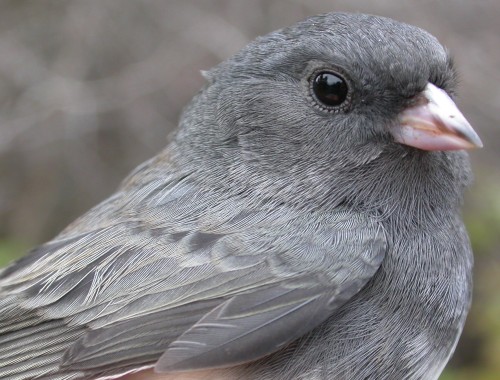 To follow up on last week’s junco story, here’s an individual with an even longer history at MBO. This male was banded early in MBO’s first winter, on November 27, 200 When we recaptured it this Friday, it was the first record of this bird since it was banded. Does it just pass through MBO late each fall (avoiding the nets last year), or is this an individual that regularly spends winter here? Perhaps this winter’s banding efforts will help answer that question. (Photo by Marcel Gahbauer) To follow up on last week’s junco story, here’s an individual with an even longer history at MBO. This male was banded early in MBO’s first winter, on November 27, 200 When we recaptured it this Friday, it was the first record of this bird since it was banded. Does it just pass through MBO late each fall (avoiding the nets last year), or is this an individual that regularly spends winter here? Perhaps this winter’s banding efforts will help answer that question. (Photo by Marcel Gahbauer)
|

 (Photo by Barbara Frei)
(Photo by Barbara Frei) We couldn’t narrow the highlights down to just one, so here are this week’s highlights: a hatch-year Black-billed Cuckoo was the first to be banded at MBO (after one escaped from our nets last Spring); a male third-year Sharp-shinned Hawk was only the 8th for MBO (all banded in fall); a young raucous Yellow-bellied Sapsucker was our 4th; and a young Ruby-throated Hummingbird, though not terribly uncommon, was one of the first to actually be well photographed! (Photos by Seabrooke Leckie) –
We couldn’t narrow the highlights down to just one, so here are this week’s highlights: a hatch-year Black-billed Cuckoo was the first to be banded at MBO (after one escaped from our nets last Spring); a male third-year Sharp-shinned Hawk was only the 8th for MBO (all banded in fall); a young raucous Yellow-bellied Sapsucker was our 4th; and a young Ruby-throated Hummingbird, though not terribly uncommon, was one of the first to actually be well photographed! (Photos by Seabrooke Leckie) – Peter Gruner and his friend Fred did a wonderful job restoring/rebuilding the existing J-trap. We expect to have it fully operational by the end of the week. (Photo by Barbara Frei)
Peter Gruner and his friend Fred did a wonderful job restoring/rebuilding the existing J-trap. We expect to have it fully operational by the end of the week. (Photo by Barbara Frei) This hatch-year male Blackburnian Warbler is only the second to be banded at MBO. (Photo by Seabrooke Leckie)-
This hatch-year male Blackburnian Warbler is only the second to be banded at MBO. (Photo by Seabrooke Leckie)- What a difference a week makes! This juvenile Veery (left), banded on the 5th, was recaptured this week showing its hatch-year plumage coming in (right), the result of its first prebasic moult. (Photos by Seabrooke Leckie)
What a difference a week makes! This juvenile Veery (left), banded on the 5th, was recaptured this week showing its hatch-year plumage coming in (right), the result of its first prebasic moult. (Photos by Seabrooke Leckie) No, we didn’t forget to update the photo! For a second straight week, a Blackburnian Warbler was the highlight. This time three individuals were caught on one day, including this after-hatch-year male (compare with
No, we didn’t forget to update the photo! For a second straight week, a Blackburnian Warbler was the highlight. This time three individuals were caught on one day, including this after-hatch-year male (compare with  Just as this week’s Blackburnian Warbler was more colourful than the one featured in last week’s report, so is the Baltimore Oriole above. The colouration is particularly remarkable given that it is a hatch-year bird, which would normally be expected to be rather pale yellow-orange. We are curious to learn whether others are also spotting such reddish orioles, and are interested in further exploring what may be causing this abnormal pigmentation. (Photo by Seabrooke Leckie)
Just as this week’s Blackburnian Warbler was more colourful than the one featured in last week’s report, so is the Baltimore Oriole above. The colouration is particularly remarkable given that it is a hatch-year bird, which would normally be expected to be rather pale yellow-orange. We are curious to learn whether others are also spotting such reddish orioles, and are interested in further exploring what may be causing this abnormal pigmentation. (Photo by Seabrooke Leckie) Despite having several breeding (or at least territorial) pairs on site, this White-breasted Nuthatch is only the 3rd to be banded at MBO. (Photo by Seabrooke Leckie)-
Despite having several breeding (or at least territorial) pairs on site, this White-breasted Nuthatch is only the 3rd to be banded at MBO. (Photo by Seabrooke Leckie)- (Photo by Seabrooke Leckie)
(Photo by Seabrooke Leckie) Here’s an example of how recapturing a bird can lead to interesting insights. This Song Sparrow was banded earlier in August and was distinctly in juvenile plumage at the time. Upon recapture on August 25, it was seen to be replacing its primary coverts sequentially, along with the corresponding primaries. Such a pattern of feather replacement was believed to occur only during second and subsequent prebasic moults, but as this bird has shown, there is still a lot to be learned about even the most common species. (Photo by Seabrooke Leckie)
Here’s an example of how recapturing a bird can lead to interesting insights. This Song Sparrow was banded earlier in August and was distinctly in juvenile plumage at the time. Upon recapture on August 25, it was seen to be replacing its primary coverts sequentially, along with the corresponding primaries. Such a pattern of feather replacement was believed to occur only during second and subsequent prebasic moults, but as this bird has shown, there is still a lot to be learned about even the most common species. (Photo by Seabrooke Leckie) We were lucky enough to have a camera on hand when MBO’s mysterious Bobolinks posed for this shot. Their appearance this fall certainly reinforces the notion that birds do not necessarily use the same feeding or roosting sites year after year, and highlights the importance of continued monitoring over coming fall seasons. (Photo by Seabrooke Leckie)
We were lucky enough to have a camera on hand when MBO’s mysterious Bobolinks posed for this shot. Their appearance this fall certainly reinforces the notion that birds do not necessarily use the same feeding or roosting sites year after year, and highlights the importance of continued monitoring over coming fall seasons. (Photo by Seabrooke Leckie) It seems like the flycatchers always have something to say to the camera; this Eastern Wood-Pewee was no exception. It was the first one caught this fall, and only the fifth ever banded at MBO. (Photo by Seabrooke Leckie)-
It seems like the flycatchers always have something to say to the camera; this Eastern Wood-Pewee was no exception. It was the first one caught this fall, and only the fifth ever banded at MBO. (Photo by Seabrooke Leckie)- We don’t know if this Sedge Wren is the same individual that we’ve been seeing on and off for the past month, or whether they’re 3 different individuals. Ah, if only it were banded! (Photo by Seabrooke Leckie)-
We don’t know if this Sedge Wren is the same individual that we’ve been seeing on and off for the past month, or whether they’re 3 different individuals. Ah, if only it were banded! (Photo by Seabrooke Leckie)- What a week for Common Grackles! Large flocks have been swirling around MBO this week, and we were lucky enough to catch 33 of these monsters. Featured here is a hatch-year male, clearly moulting his juvenal brown feathers for the more elegant iridescent bluish-black look. (Photo by Seabrooke Leckie)
What a week for Common Grackles! Large flocks have been swirling around MBO this week, and we were lucky enough to catch 33 of these monsters. Featured here is a hatch-year male, clearly moulting his juvenal brown feathers for the more elegant iridescent bluish-black look. (Photo by Seabrooke Leckie) Despite losing our beloved visiting-BIC Seabrooke, this week has been amazing! So amazing, in fact, that we couldn’t narrow the list of “special” pictures to less than 6. These species are all intriguing because we don’t band many of them at MBO. Pictured clockwise from top left are: Gray-cheeked Thrush, Winter Wren, Orange-crowned Warbler, male House Finch, Savannah Sparrow, and Palm Warbler – all of them hatch-year birds! (Photos by Barbara Frei and Marie-Anne Hudson)-
Despite losing our beloved visiting-BIC Seabrooke, this week has been amazing! So amazing, in fact, that we couldn’t narrow the list of “special” pictures to less than 6. These species are all intriguing because we don’t band many of them at MBO. Pictured clockwise from top left are: Gray-cheeked Thrush, Winter Wren, Orange-crowned Warbler, male House Finch, Savannah Sparrow, and Palm Warbler – all of them hatch-year birds! (Photos by Barbara Frei and Marie-Anne Hudson)- We love nothing more than showing the differences between species, and nothing makes it easier than getting a side-by-side shot. It certainly was considerate of this House Wren and this Winter Wren to enter the nets on the same net round! In this case the key differences, colour and tail length, are made vividly clear. The House Wren is larger, a mousey brown with a (relatively) long tail. The Winter Wren is smaller, with a richer, more rusty colour, and a stubby little tail. (Photo by Barbara Frei) .
We love nothing more than showing the differences between species, and nothing makes it easier than getting a side-by-side shot. It certainly was considerate of this House Wren and this Winter Wren to enter the nets on the same net round! In this case the key differences, colour and tail length, are made vividly clear. The House Wren is larger, a mousey brown with a (relatively) long tail. The Winter Wren is smaller, with a richer, more rusty colour, and a stubby little tail. (Photo by Barbara Frei) . A surprising species in this week’s top ten: Black-throated Green Warbler! Although they are not as showy in basic plumage as they are during the breeding season, their olive-green backs and bright yellow cheeks add a splash of colour to fall. (Photo by Barbara Frei)-
A surprising species in this week’s top ten: Black-throated Green Warbler! Although they are not as showy in basic plumage as they are during the breeding season, their olive-green backs and bright yellow cheeks add a splash of colour to fall. (Photo by Barbara Frei)- We had two candidates for the new ‘oddities’ page that we are putting together, which displays the strange things that can be encountered while banding. These ‘cross-billed’ individuals – a Common Yellowthroat and White-throated Sparrow – were both fat and seemingly healthy adults! They seem to have survived well despite their challenges – or perhaps have even found a way to benefit from them. (Photos by Barbara Frei) .
We had two candidates for the new ‘oddities’ page that we are putting together, which displays the strange things that can be encountered while banding. These ‘cross-billed’ individuals – a Common Yellowthroat and White-throated Sparrow – were both fat and seemingly healthy adults! They seem to have survived well despite their challenges – or perhaps have even found a way to benefit from them. (Photos by Barbara Frei) . A bird in the hand may be worth two in the bush – but I don’t know – there were a LOT of Yellow-rumped Warblers in the bushes around MBO! With 49 caught Friday, 27 Sunday, and 48 Monday (with very few recaptures) you have to wonder – how many are out there? Well, since they are one of our target boreal birds, the more the merrier! (Photo by Barbara Frei) .
A bird in the hand may be worth two in the bush – but I don’t know – there were a LOT of Yellow-rumped Warblers in the bushes around MBO! With 49 caught Friday, 27 Sunday, and 48 Monday (with very few recaptures) you have to wonder – how many are out there? Well, since they are one of our target boreal birds, the more the merrier! (Photo by Barbara Frei) . This hatch-year male Sharp-shinned Hawk added further excitement to a record-breaking week. (Photo by Marie-Anne Hudson)-
This hatch-year male Sharp-shinned Hawk added further excitement to a record-breaking week. (Photo by Marie-Anne Hudson)- While Yellow-rumped Warblers dominated the nets this week, a number of other warbler species were banded in smaller numbers, including (at last) our first Northern Parula of the Fall 2006 season. (Photo by Barbara Frei)
While Yellow-rumped Warblers dominated the nets this week, a number of other warbler species were banded in smaller numbers, including (at last) our first Northern Parula of the Fall 2006 season. (Photo by Barbara Frei) This week, species banded for the first time this season included Brown Creeper and the Fox Sparrow shown above. This is among the few species that is likely to become increasingly common over the final three weeks of the season, usually dominated by American Robins and a variety of sparrow species. (Photo by Barbara Frei)-
This week, species banded for the first time this season included Brown Creeper and the Fox Sparrow shown above. This is among the few species that is likely to become increasingly common over the final three weeks of the season, usually dominated by American Robins and a variety of sparrow species. (Photo by Barbara Frei)- It seems there are always birds in the large dead tree near the north end of Stoneycroft Pond, and it’s always a good idea to look closely at them for potential surprises. Can you spot the four species in the photo above? Answer at the end of this week’s report. (Photo by Barbara Frei)
It seems there are always birds in the large dead tree near the north end of Stoneycroft Pond, and it’s always a good idea to look closely at them for potential surprises. Can you spot the four species in the photo above? Answer at the end of this week’s report. (Photo by Barbara Frei) The confusing fall warblers may be largely past us at this point, but this does not mean there are no challenges remaining. Sparrows are often regarded as a confusing bunch – more so when they do not look as expected. The large sparrow above has tricked many. However, if you look closely at the bill and facial pattern, it is very similar to that of the bird below, easily recognizable as a White-crowned Sparrow. In fact, while the plumage above can be confusing at first, its distinctiveness makes this the easiest of the sparrows for which to distinguish between hatch-year (above) and after-hatch-year (below) birds. (Photos by Marcel Gahbauer)
The confusing fall warblers may be largely past us at this point, but this does not mean there are no challenges remaining. Sparrows are often regarded as a confusing bunch – more so when they do not look as expected. The large sparrow above has tricked many. However, if you look closely at the bill and facial pattern, it is very similar to that of the bird below, easily recognizable as a White-crowned Sparrow. In fact, while the plumage above can be confusing at first, its distinctiveness makes this the easiest of the sparrows for which to distinguish between hatch-year (above) and after-hatch-year (below) birds. (Photos by Marcel Gahbauer) Occasionally, there are hatch-year White-crowned Sparrows that are already showing a bit of white and black in their crown, like the individual below captured this week. (Photo by Barbara Frei)
Occasionally, there are hatch-year White-crowned Sparrows that are already showing a bit of white and black in their crown, like the individual below captured this week. (Photo by Barbara Frei)
 Here’s lookin’ at you, kid… Or at least that what we think this pale American Robin was saying as it posed for us Monday morning. While it wasn’t leucistic or albino, this bird is definitely different! (Photo by Gay Gruner)
Here’s lookin’ at you, kid… Or at least that what we think this pale American Robin was saying as it posed for us Monday morning. While it wasn’t leucistic or albino, this bird is definitely different! (Photo by Gay Gruner) A side view of this week’s unusually pale American Robin (Photo by Gay Gruner)
A side view of this week’s unusually pale American Robin (Photo by Gay Gruner) It’s rare to get such a clear shot of a vireo, but this little guy posed quite nicely for us while deciding where to fly after being released. Notice the band? (Photo by Barbara Frei)
It’s rare to get such a clear shot of a vireo, but this little guy posed quite nicely for us while deciding where to fly after being released. Notice the band? (Photo by Barbara Frei) This young European Starling gave us its impression of a Common Nighthawk, opening its mouth larger than we ever thought possible! We suppose it was excited that it was only the third starling ever to be banded at MBO. (Photo by Marcel Gahbauer)
This young European Starling gave us its impression of a Common Nighthawk, opening its mouth larger than we ever thought possible! We suppose it was excited that it was only the third starling ever to be banded at MBO. (Photo by Marcel Gahbauer) This after-hatch-year male Slate-colored Junco returned to us after having been banded last February during the winter banding season. Thanks to André Pelletier (plus camera) for his determined pursuit of released birds. It’s always nice to see them perched comfortably post-release. (Photo by André Pelletier).
This after-hatch-year male Slate-colored Junco returned to us after having been banded last February during the winter banding season. Thanks to André Pelletier (plus camera) for his determined pursuit of released birds. It’s always nice to see them perched comfortably post-release. (Photo by André Pelletier). Marie-Anne just HAD to get a better look at the passing raptors. Too bad they were gone by the time she scrambled up the windmill. (Photo by Marcel Gahbauer)
Marie-Anne just HAD to get a better look at the passing raptors. Too bad they were gone by the time she scrambled up the windmill. (Photo by Marcel Gahbauer) The highlight of our final week of the 2006 fall season was this after-hatch-year male Indigo Bunting, banded on Friday morning. That date was over three weeks later than that of the latest individual in 2005, and even that one was considered to be unusually delayed in its migration. However, this bird was in great condition, carrying more fat than any other bird banded the rest of the morning. (Photo by Marcel Gahbauer)
The highlight of our final week of the 2006 fall season was this after-hatch-year male Indigo Bunting, banded on Friday morning. That date was over three weeks later than that of the latest individual in 2005, and even that one was considered to be unusually delayed in its migration. However, this bird was in great condition, carrying more fat than any other bird banded the rest of the morning. (Photo by Marcel Gahbauer) To follow up on last week’s junco story, here’s an individual with an even longer history at MBO. This male was banded early in MBO’s first winter, on November 27, 200 When we recaptured it this Friday, it was the first record of this bird since it was banded. Does it just pass through MBO late each fall (avoiding the nets last year), or is this an individual that regularly spends winter here? Perhaps this winter’s banding efforts will help answer that question. (Photo by Marcel Gahbauer)
To follow up on last week’s junco story, here’s an individual with an even longer history at MBO. This male was banded early in MBO’s first winter, on November 27, 200 When we recaptured it this Friday, it was the first record of this bird since it was banded. Does it just pass through MBO late each fall (avoiding the nets last year), or is this an individual that regularly spends winter here? Perhaps this winter’s banding efforts will help answer that question. (Photo by Marcel Gahbauer)